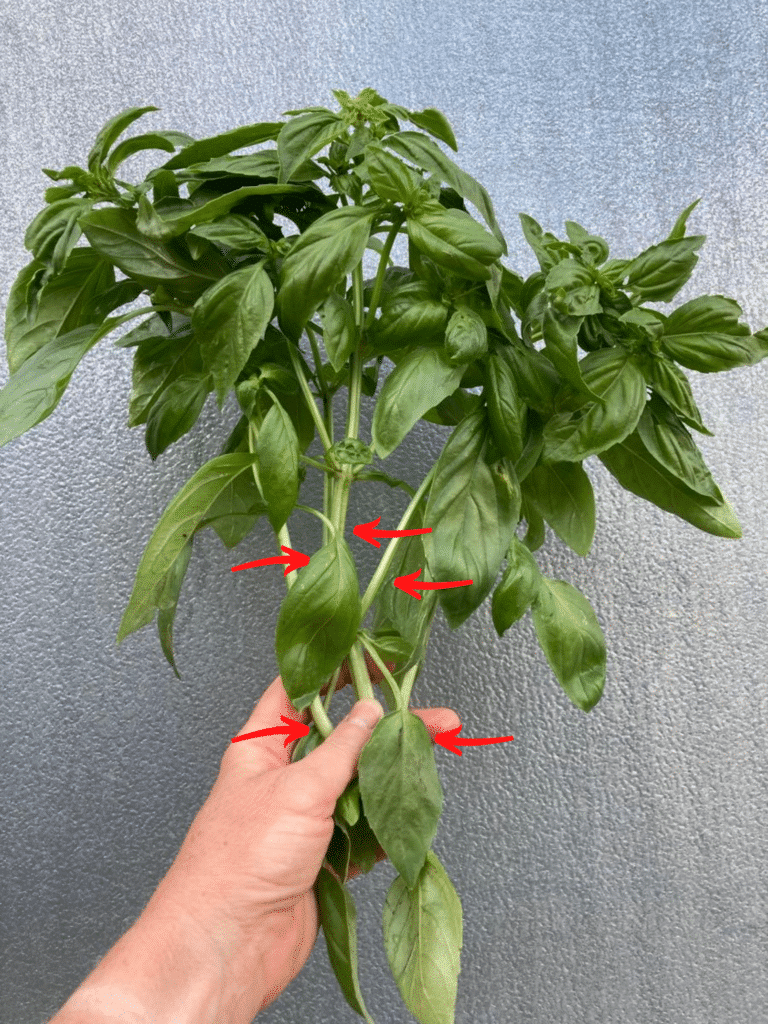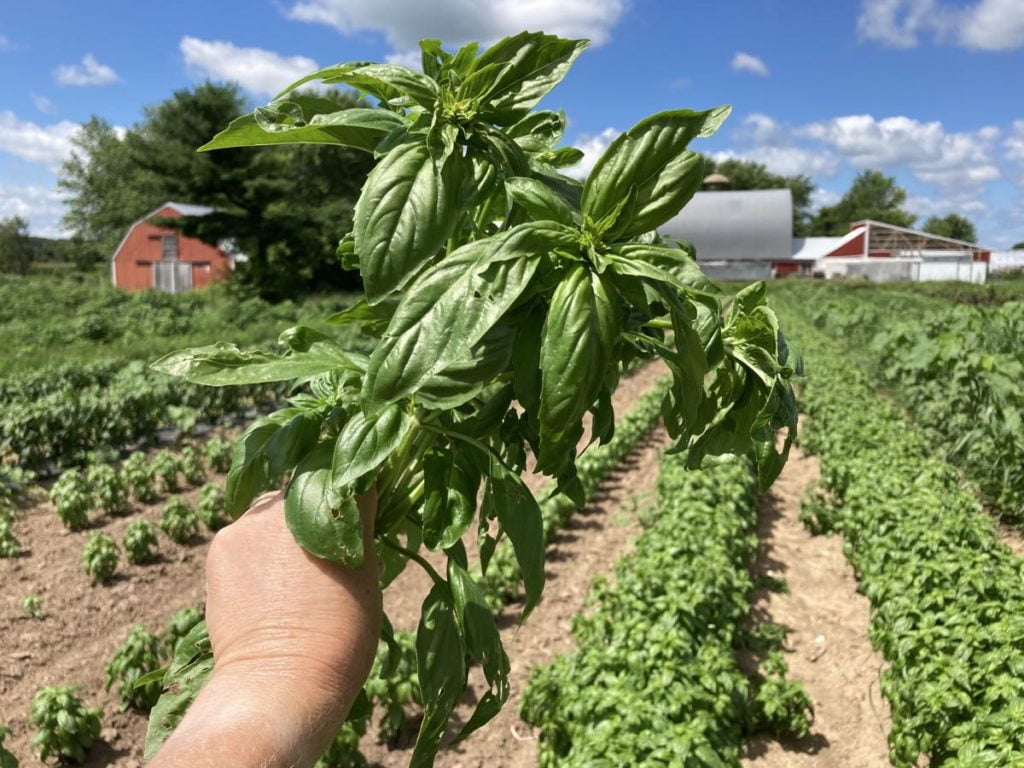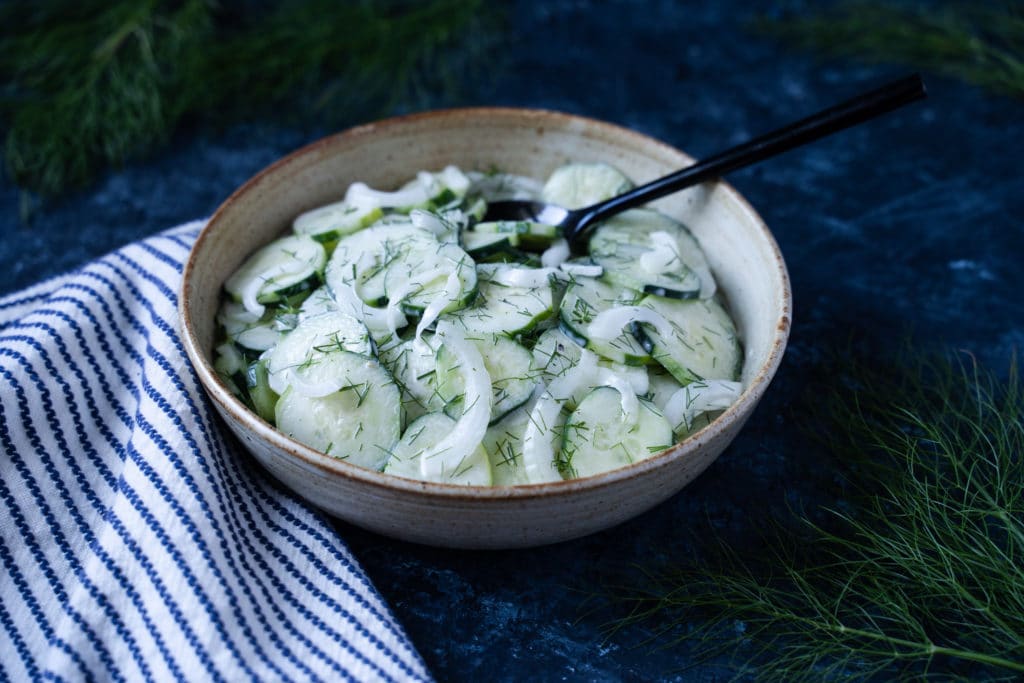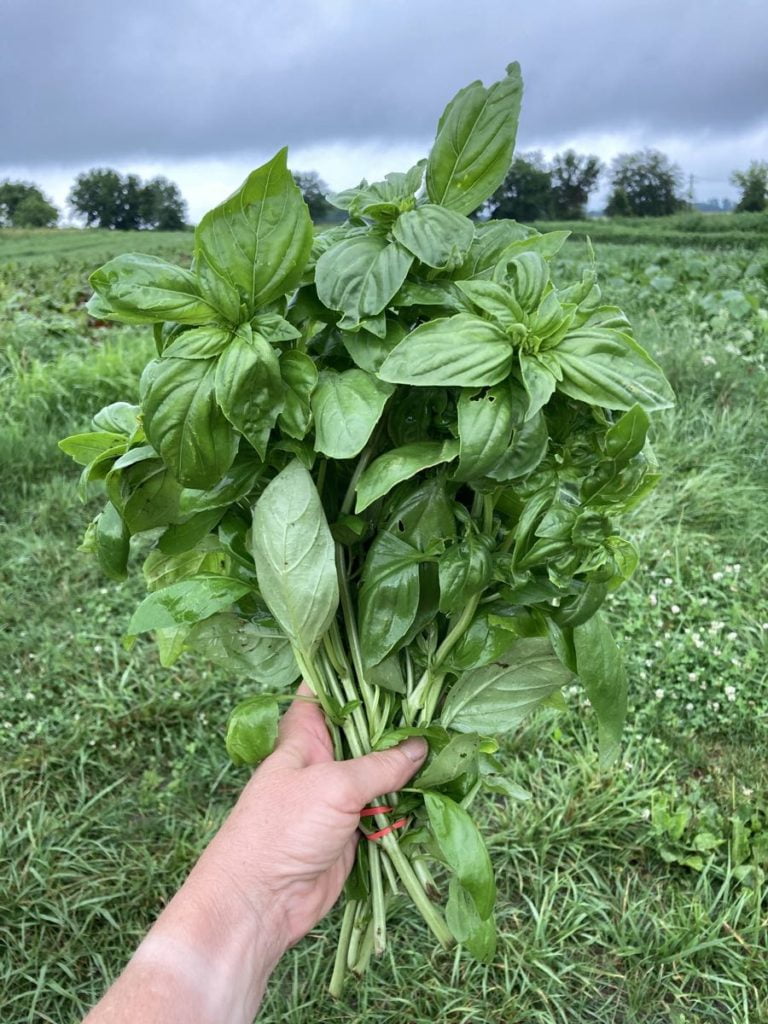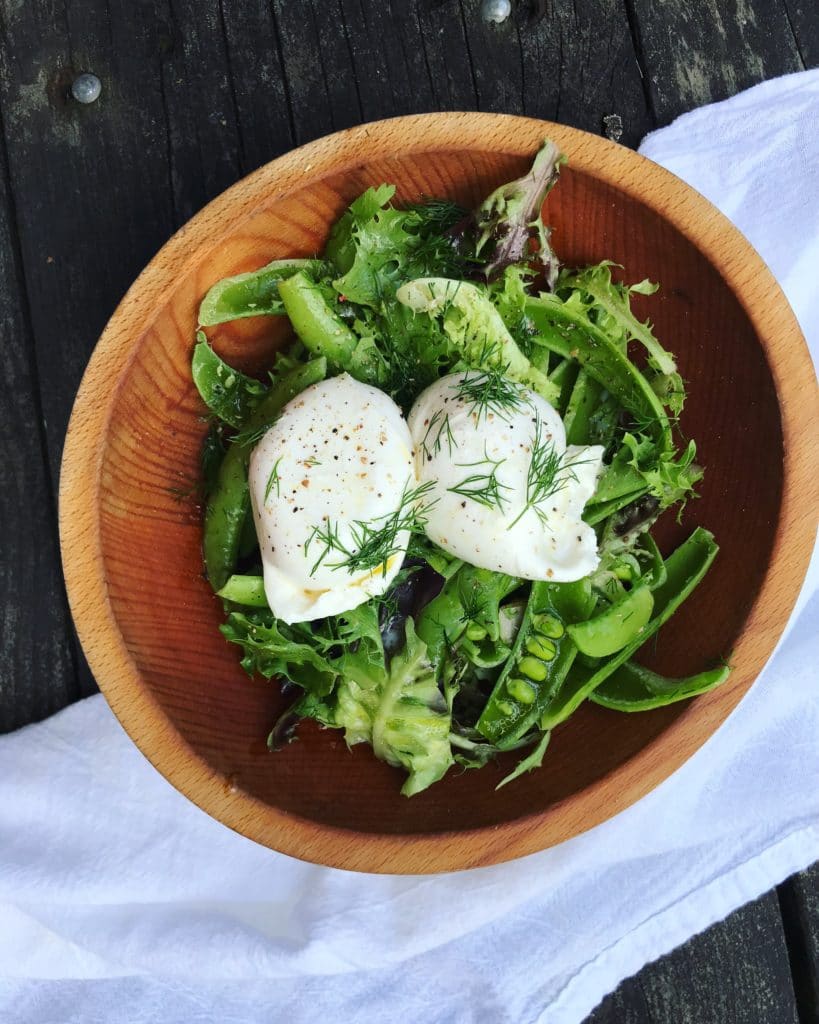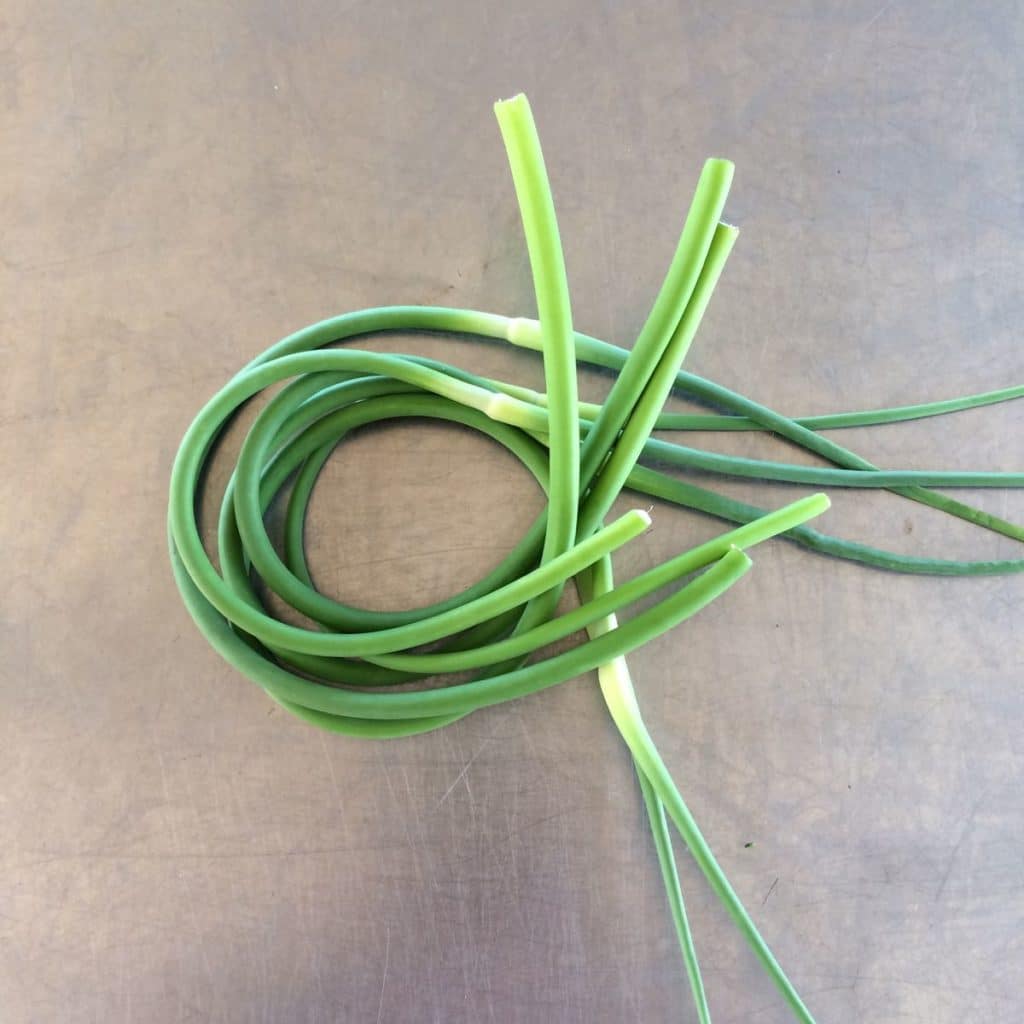Monthly Archives: July 2020
Week #11, Food Safety Inspection!
- On: July 29, 2020
 2
2

DATCP inspector Michael Barta reviews our hand and tool-washing arrangements, and a pile of paperwork and record-keeping.
We passed our first official inspection under the Federal Food Safety Act (FSMA), following a preliminary ‘walk through’ last year. The inspection went well! We passed!
FSMA is a big deal for us and for other vegetable growers. It’s a federal law intended to prevent outbreaks of food borne illness like E. coli and salmonella on lettuce, melons, etc. The final law was years in the making. Some of the early versions were awful, eg telling us to eliminate (ie kill) all wildlife.
We started the process in a secure position, the result of two decisions Steve and I made when setting up our farm.
1. We do not use any surface water for irrigation, for example from a pond or creek. Our deep irrigation well is much less vulnerable to contamination than surface water.
2. We don’t have any livestock on the farm, not even a flock of chickens. Dealing with raw animal manure on a vegetable farm is tricky. It can be done but brings a lot of risk.
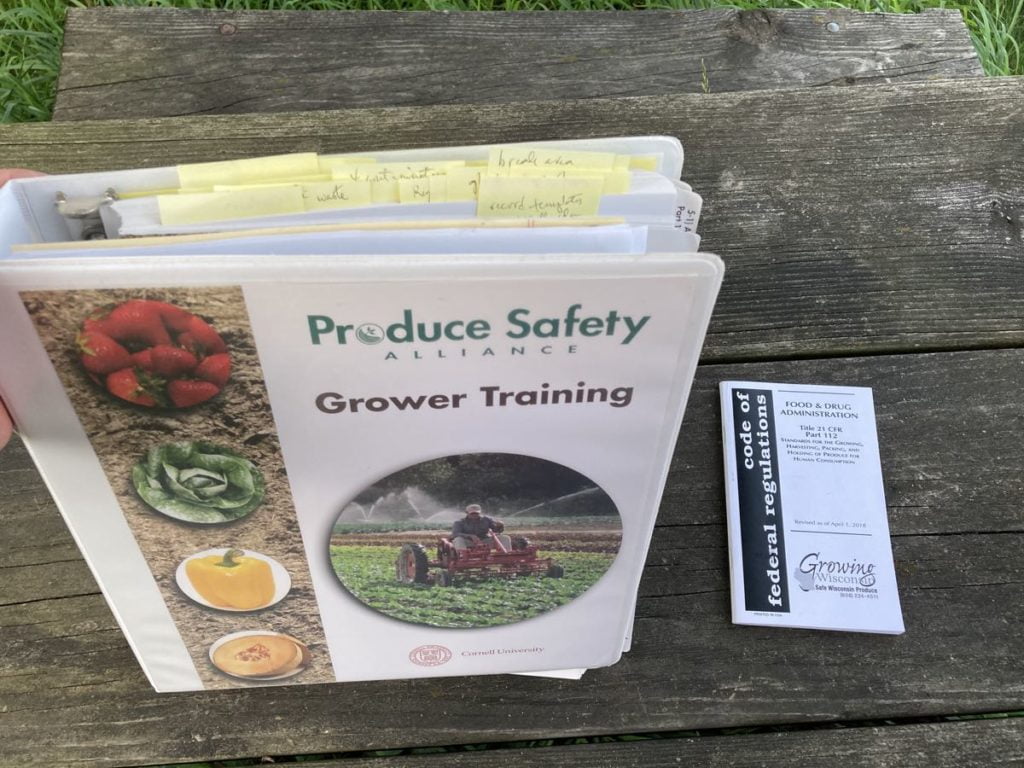
Complying with this federal law has been intimidating at times. I was given the training manual at left when taking a grower training two winters ago. Compare that with the condensed version at right that we work from now.
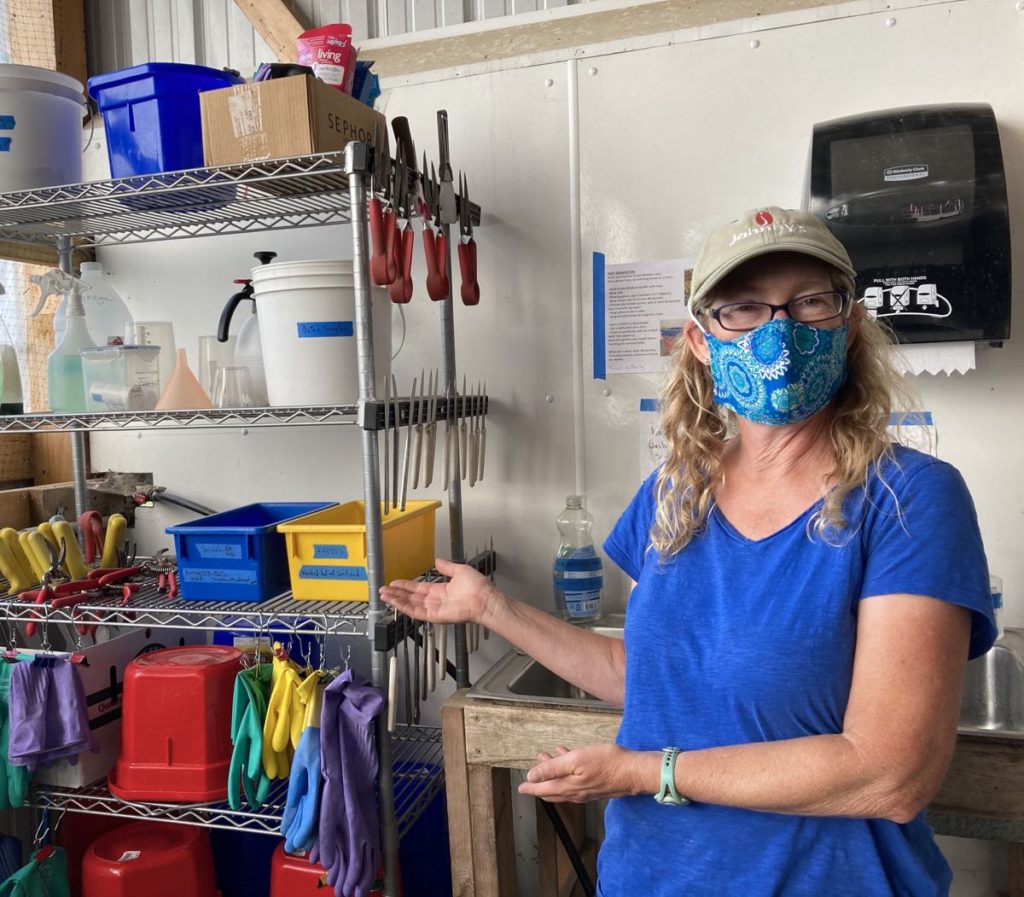
COVID-19 has forced changes for our farm, all of which benefit our food safety program. Some of the changes were simply better organization. I set up this tool washing station in our outdoor washroom and everyone immediately adopted it. Defined storage for each tool, central storage for cleaning and sanitizing supplies, rubber gloves for everyone, color-coded pails (blue = sanitized, red = dirty). I should have done this years ago. Beth
We are hiring.
We have several openings for farmhands to replace crew members who are returning to school or pre-pandemic careers. We offer valuable work, outdoors in a safe, friendly environment. Plus you get to take home lots of healthy produce. Please spread the word. Learn more at http://bit.ly/TipiJobs .
Keeping basil fresh
As usual, I encourage you to store your basil at room temperature in a glass of water, just like a bouquet of flowers. Cold temperatures damage basil, and it will blacken in the fridge. However, I neglected to tell you that big, branched stems should be cut into small stems, to avoid wilting. A big stem like in the photo could wilt.
Look at the photo and you’ll see that we can get five stems from this plant. Wet the plant, then cut free the bottom two stems (below my thumb), then the next two stems up the stalk (above my thumb, one is hidden). Cut the main stem just above that. Put all the stems in water. You’ll have a few loose leaves to deal with but most leaves will still be attached. Use a sharp knife or shears!
If your basil (or any greens) are already wilted, try submerging in a basil of water. For basil, submerge just a few minutes in room temperature water. For kale, lettuce or spinach, submerge for 15 minutes in cold water. I hope this helps.
This week’s basil stems are less heavily branched but we’ll send big stems again in the future. Beth
Veggie List & Veggie Notes
Week #11, July 30/31, 2020
– Weekly shares
– EOW/ green
Sweet corn, ~10 ears
Green beans, ~1/2 lb
Tomatoes, plum or slicing, 2 lb
Pepper, 1 small red bell or frying pepper
Zucchini/squash, maybe 1
Broccoli, 1 or 2 heads
Cucumbers, 1 or 2
Walla Walla onion
Basil, 1 bunch
Some sites get red watermelon. Some sites get muskmelon. Some sites get a Korean melon.
Next week’s box will probably contain tomatoes, lettuce, peppers, melon, and other summer crops.
Sweet corn – There are far fewer bugs than last week. Yeah! This is a really nice batch of corn this week.
Watermelon – These are red, seeded melons. If uncut, watermelon can be stored at room temperature for a week. Refrigerate once it’s cut.
Muskmelon – Some are ripe and ready to eat. Some need to ripen a day or two on your kitchen counter. Keep at room temperature but refrigerate if not eaten within 2 – 3 days.
Korean melon (yellow, oblong) – These unusual melons are sweet and crisp, reminiscent of a good honeydew. This new variety ‘Torpedo’ is an improvement over previous varieties. They are ready to eat. Refrigerate.
RECIPES
Visit our 2020 Recipe Log or our 2019 Recipe Log or join our Facebook discussion group.
LOCAL THYME/ Cooking 101
Broccoli Tomato Basil Salad
Tomato Cucumber Corn Panzanella
Tomato and Melon Salad with Basil Oil
LOCAL THYME/ Cooking 202
Quinoa Veggie Bowl with Broccoli, Tomato, Sweet Pepper and Feta
Black Bean and Veggie Enchiladas
Summer Squash and Tomato Sandwiches with Basil Mayo
LOCAL THYME/ Quick & Easy Meal
Roasted Fish with Tomato with Basil
RECIPES FROM LAUREN
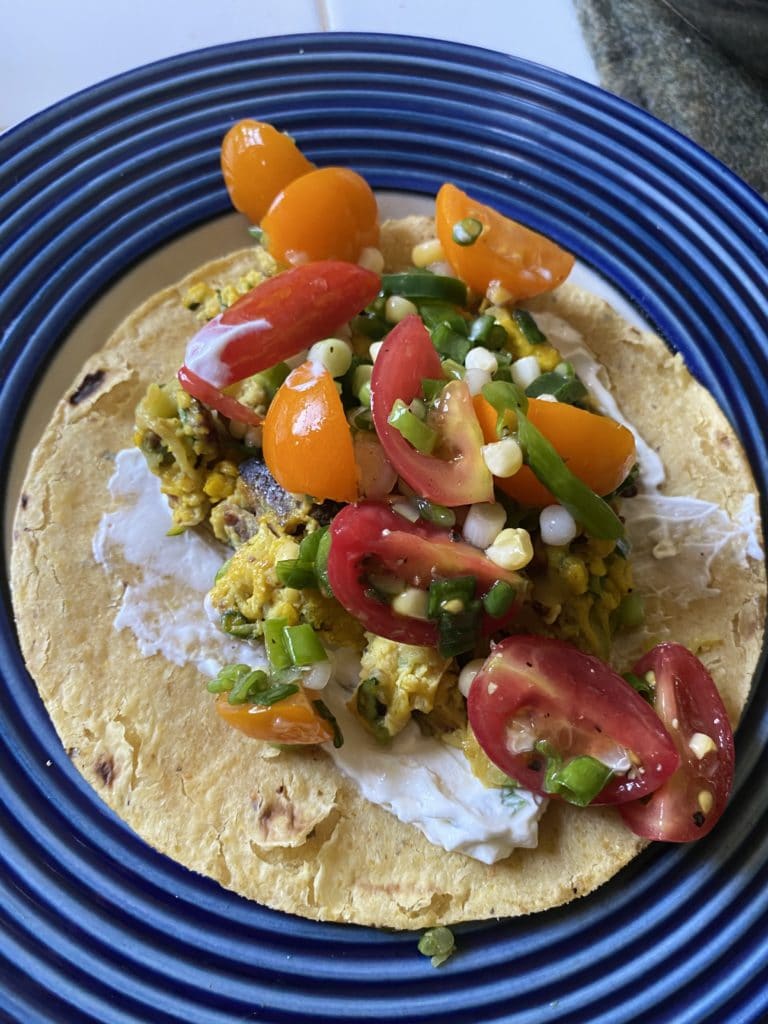
ZUCCHINI BREAKFAST TACOS WITH SWEET CORN SALSA
Serves 2 generously.
Takes 25 minutes.
3 pieces bacon
1 tablespoon butter
2 garlic cloves
1 medium zucchini, shredded
1/2 teaspoon Kosher salt
10 twists black pepper
4 eggs
1/4 cup milk
4-6 corn tortillas (we’re obsessed with the new Bandit Tortilleria in Madison!)
Sour cream, optional
Hot sauce, optional
- Prepare your bacon however you like. We always lay it out on a baking sheet and place it in a cold oven. Set the temperature to 400 degrees and the timer for 15 minutes for regular or 20 minutes for thick cut. Generally, this gets us perfect crispy (but not burnt) bacon every time. Drain on a paper towel and reserve for later.
- Melt butter in a large skillet. Add garlic, zucchini, salt and pepper. Saute over medium heat for 5-6 minutes, until the zucchini has dried out and begun to caramelize a bit, but is no where near close to burning or blackening. The garlic should also smell fragrant. Reduce heat to low.
- Roughly chop bacon and add to zucchini and garlic.
- In a small bowl, whisk eggs and milk until smooth.
- Add eggs to zucchini mixture and scramble gently with a spatula. We like to scramble our eggs over low heat. It will take about 10 minutes but they will be soft and tender every time. They won’t need constant attention. While you slowly scramble the eggs, feel free to prepare your sweet corn salsa (recipe below).
- To serve, warm tortillas however you like (dry skillet, microwave, toaster oven). Add eggs and top with salsa. Feel free to add sour cream or hot sauce if you desire. Devour immediately.
.
Sweet Corn Salsa
2 ear corn
1 pound diced tomatoes
1 colored pepper, finely chopped
1/2 Walla Walla onion, finely chopped
1/2 lime, juiced
1/2 teaspoon Kosher salt
5 twists black pepper
- Using a knife, remove the kernels from your ear of corn. You do not need to cook the sweet corn. It is milky and creamy when eaten raw.
- Combine corn and remaining ingredients in a small bowl. Toss gently to combine.
.
????
.
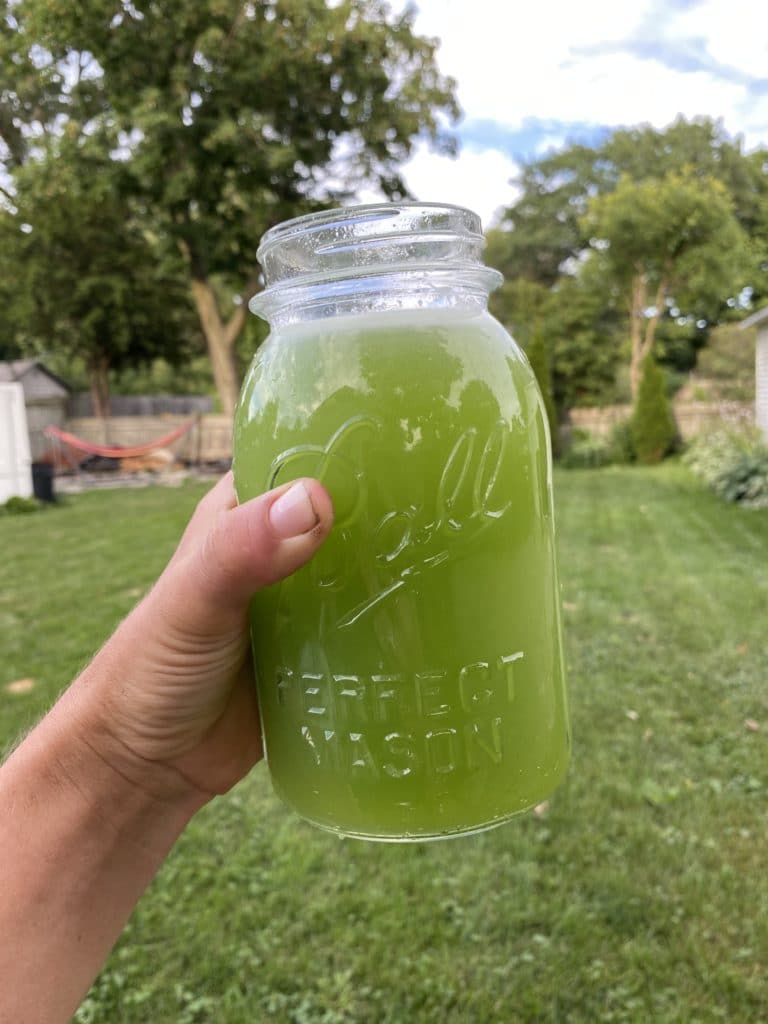
CUCUMBER BASIL AQUA FRESCA
Makes 1 quart
2 cucumbers, roughly chopped
1/2 cup packed basil leaves
1/3 cup lemon (or lime) juice
1/2 cup sugar
4 cups water (or fizzy water), divided
- Combine cucumbers, basil, lemon juice, sugar and 2 cups water in a food processor or blender until cucumbers are finely chopped.
- Strain into a pitcher or large mason jar. Add remaining water and shake or stir to combine.
- Drink immediately or chill before stirring.
.
????
.
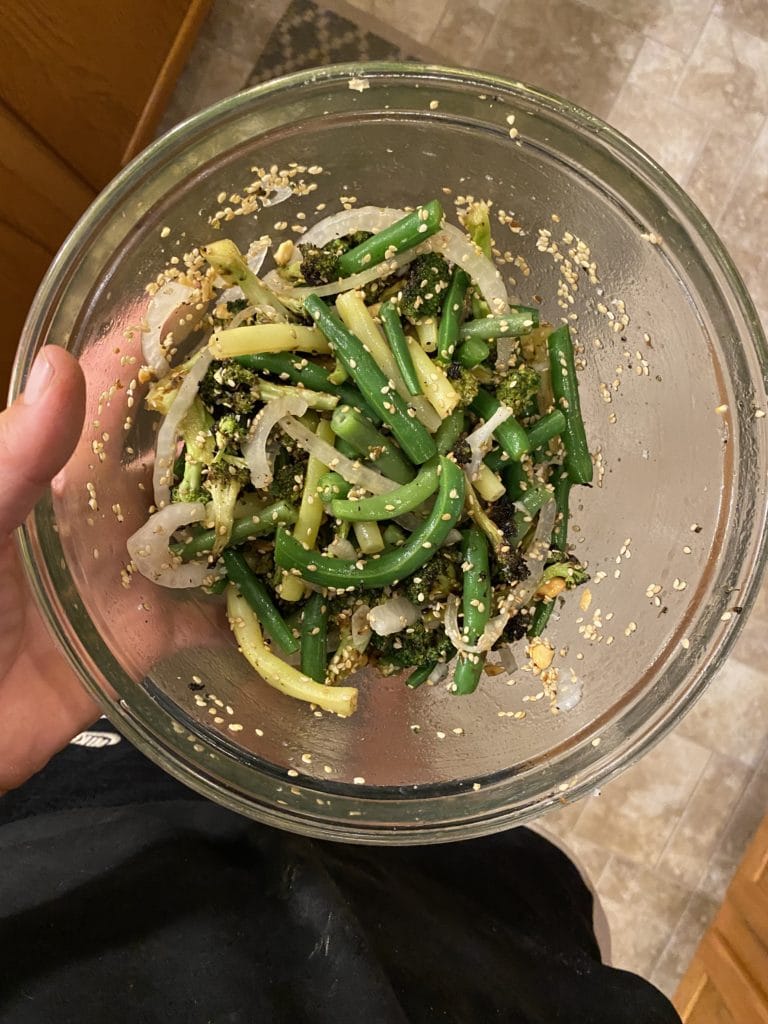
BROCCOLI & GREEN BEAN SALAD WITH PEANUTS
Serves 2-4
Takes 20 minutes
1/4 cup olive oil, divided
1 head broccoli, cut into florets
1/2 teaspoon Kosher salt
1/2 pound green beans, ends trimmed and halved
1/4-1/2 Walla Walla onion, sliced (as much or as little as you want is great!)
1 teaspoon sugar
1 tablespoon rice wine vinegar
1/4 cup dry roasted peanuts, roughly chopped
2 tablespoons toasted sesame seeds
Flaky sea salt, to taste
- In a large skillet, warm 2 tablespoons of olive oil over medium heat. Add broccoli florets and cook about 10 minutes, until tender and charred in places. Season with salt.
- In a medium saucepan or kettle, bring water to a boil. Once boiling, add green beans and cook for 3 minutes. Drain and rinse under cold water.
- In a medium bowl, combine warm broccoli, cooled beans and onion. Toss with sugar, rice wine vinegar and remaining 2 tablespoons olive oil.
- Add roasted peanuts, sesame seeds and salt right before serving.
.
Week #10; A Good Week
- On: July 22, 2020
 0
0

This was a good week, following difficult times after a lightning strike two weeks ago. We’ve gotten almost everything repaired, including the expensive controller for our irrigation well. We held our breath on that one. Once the controller was fixed, we could test the pump and fortunately it was not damaged. We still need to get electronics for our solar array fixed but have not yet been able to line up someone to do the repairs. (photo credit Ari P-K)
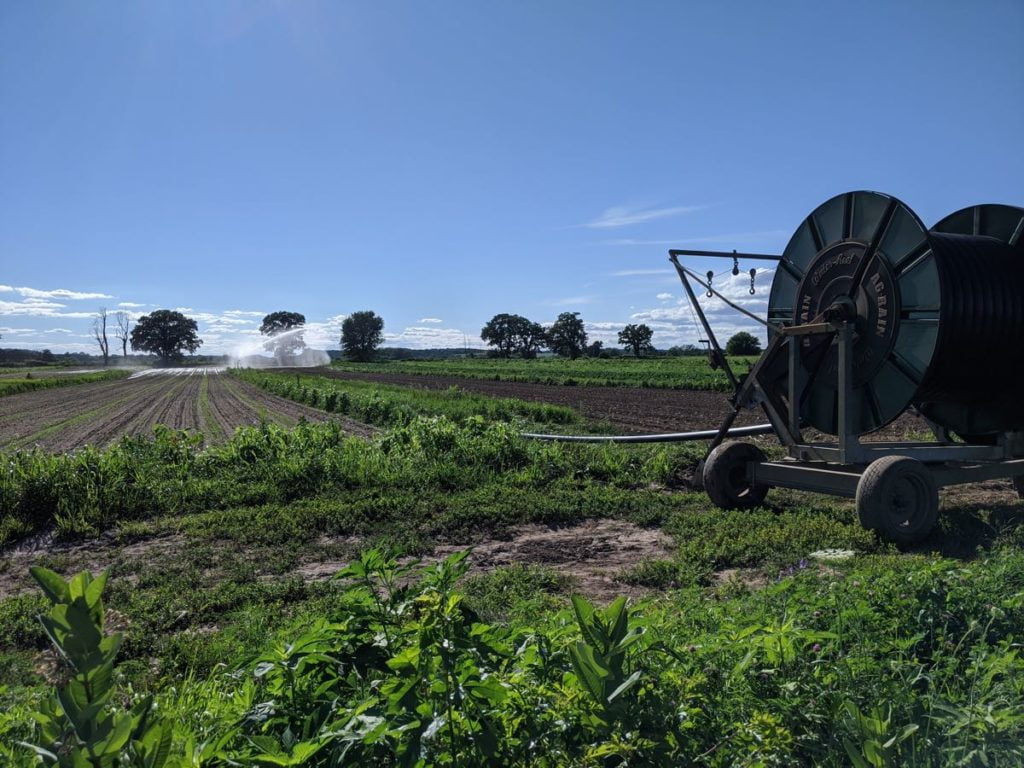
There’s been plenty of rain for most crops, except our young carrot plantings. We seeded a sequence of carrot fields right before the lightning strike. The carrots need steady moisture to emerge. Usually we irrigate lightly for 12 days. This year we had to rely on rain as it took over a week to get the irrigation well running again. So far the fields look fine because there was enough rain to keep the tiny seeds moist as they germinated. (photo credit Ari P-K)
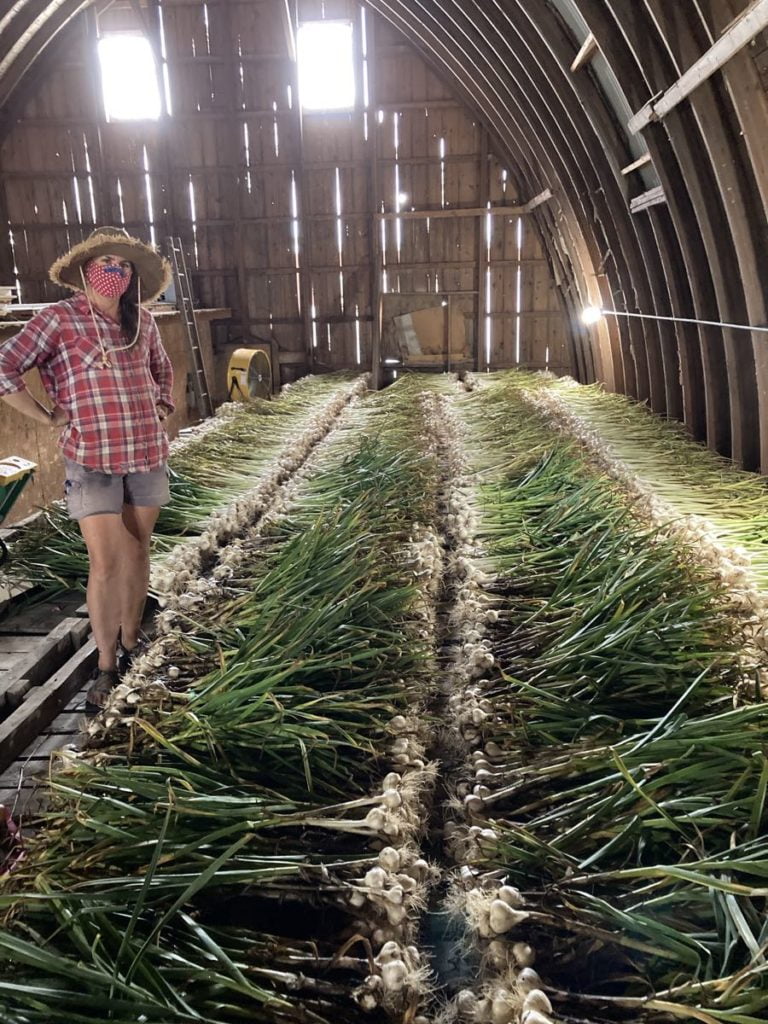
We harvested almost our entire garlic crop over the past week. There’s still a few hundred bulbs to pull. We dry the garlic upstairs in our well-ventilated barn, laying the stalks on overturned wooden bins. The masked bandoleer is neighbor/employee/friend Karen who helps with garlic every year. She grows seed garlic on her farm, so I rely on her expertise as we harvest our garlic crop.

We have to say goodbye to employee David (left, harvesting your basil with Ben). David returned to work for us during the pandemic, but now is leaving for a job in his field (wine making). We were glad to have him back – he’s worked for us several times over the past ten years, when he’s been available between other adventures.
The basil is growing extraordinarily well this year so we’re sending another nice bunch. We usually overplant in anticipation of losing some to to disease. Instead, it is unexpectedly lush. We’ll continue to send it frequently. If it’s too much, freeze some for winter. You’ll be glad you did.
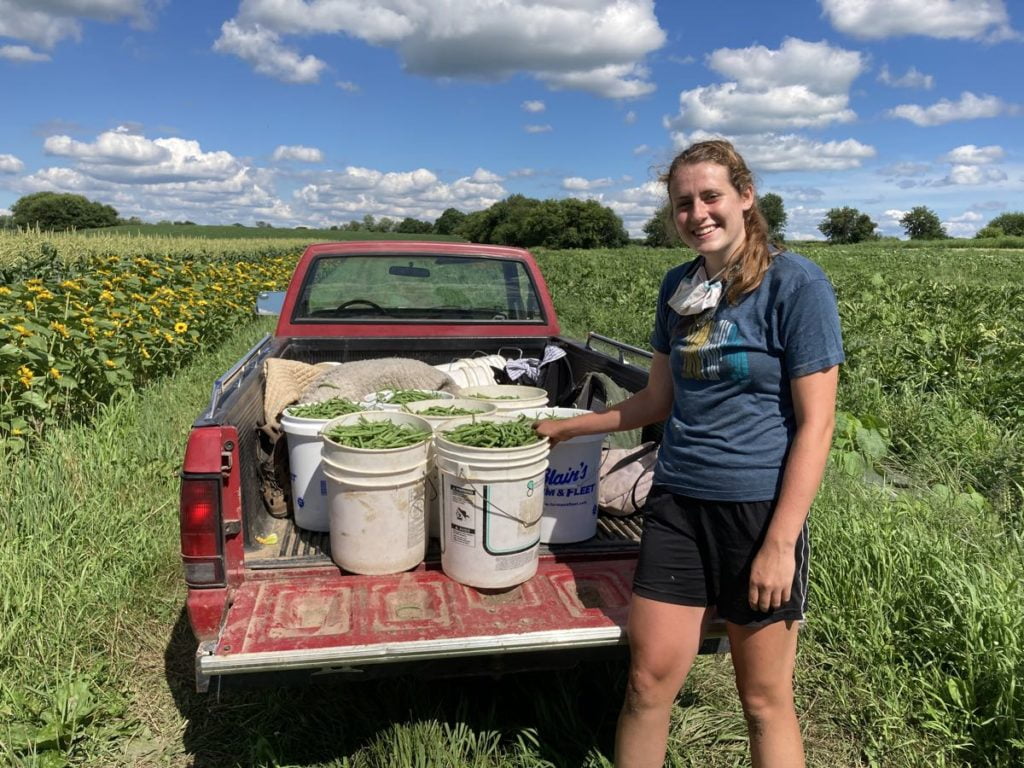
All our farm work is so much easier in the cooler weather! Zoe brings in the bean harvest.
Veggie List & Veggie Notes
Week #10, July 23/24, 2020
– Weekly shares
– EOW/ purple
– Sampler/ sun
Sweet corn, ~8 ears
‘Caraflex’ cabbage
Green beans, 3/4 lb
Cherry tomatoes, 1 pint
Tomatoes, a few slicing or plum tomatoes
Cucumbers, 3
Green bell pepper, 1 small
Walla Walla onion, 1 large
Basil, 1 bunch
Each site gets globe eggplant OR broccoli OR zucchini OR extra corn.
Next week’s box will probably contain sweet corn, green beans, tomatoes and other summer crops!
Sweet corn – Now it’s summer! Some ears have bugs at the tip. I suggest cutting off the tips before shucking the corn.
Storage. Sweet corn is best when fresh, so we encourage you to eat it asap. Store in the refrigerator, in the husks if you have the room, or husked in a plastic bag.
Cooking. It is quicker to steam sweet corn than to boil it.
1.) Stand ears of corn upright in a tall pot. Put one inch of water in the pot.
2.) Bring the water to a boil. If the corn is cold when you begin cooking, steam for 5 – 6 minutes. If the corn starts at room temperature, steam for 4 – 5 minutes. The cooking time will vary somewhat depending on how many ears are in the pot. Pay attention to how the corn smells. The scent changes once the corn is ready. Another clue: water will bead on the corn until it is cooked. Don’t overcook it.
‘Caraflex’ cabbage – This is the same type of cabbage we sent three weeks ago. This ‘salad’ type is great for slaws and raw salads but handles light cooking too.
Green beans – Store in the warmer part of your fridge.
Tomatoes (plum or slicing) – Store your tomatoes at room temperature to preserve flavor and texture.
RECIPES
Visit our 2020 Recipe Log or our 2019 Recipe Log or join our Facebook discussion group.
LOCAL THYME/ Cooking 101
Corn Pudding
Roasted Chicken and Cabbage Dinner
Green Bean Salad with Basil and Pine Nuts
LOCAL THYME/ Cooking 202
Caramelized Corn with Basil
Roasted Caraflex Cabbage with Gruyere
Pesto Pasta Salad with Green Beans and Corn
LOCAL THYME/ Quick & Easy Meal
Composed Chicken Salad with Buttermilk Dressing
RECIPES FROM LAUREN
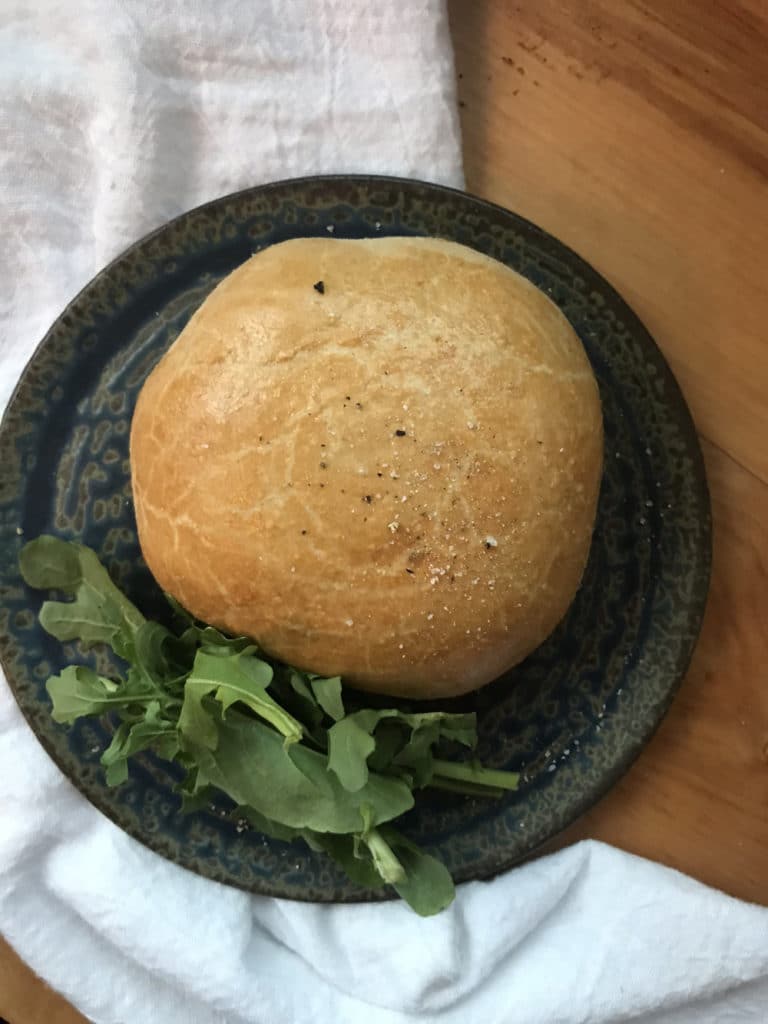
RUNZA
What the heck is runza you ask? Well, officially, it is the state dish of Nebraska. But closer to home, it is a dish I grew up with when my mom had extra cabbage in her garden. It’s essentially a German-style calzone packed full of ground meat (traditionally beef, but here I used pork because it’s what I had on hand), cabbage, and onions. I know making your own dough can seem intimidating but give it a try. It’s easier than you think.
Makes 8 runzas
Takes 2 hours
Dough:
3/4 cup lukewarm water
2-1/4 teaspoons active yeast
Pinch sugar + 3 tablespoons sugar, divided
4 eggs; 3 for dough, 1 for egg wash
4 cups all-purpose flour, divided + more for dusting counter
12 tablespoons butter, softened
2 teaspoons Kosher salt
Filling:
1 tablespoon olive oil
1 pound ground pork
1 teaspoon Kosher salt, divided
1/2 teaspoon black pepper
1/2 Walla Walla, diced
1 green pepper, seeded and diced
2 tablespoons butter
1 head cabbage, shredded
1 teaspoon dried thyme
1/2 teaspoon dried sage
- In a large bowl, combine water (it should be warm but not hot), yeast and sugar. Whisk gently to combine. Let sit for 10 minutes until it bubbles, rises and smells yeasty. Add 3 eggs and whisk to combine. Add half the flour and beat with a spoon until totally incorporated. Add butter, remaining flour, sugar and salt. Stir until just combined and then let rest for 15 minutes.
- Once rested, dust counter with flour and knead dough for 5 minutes until tight and smooth. Transfer the dough to a clean, greased bowl. Cover with plastic wrap and let rise in a warm space for an hour (until doubled in size).
- When the dough is about 20 minutes from finished, preheat the oven to 375 degrees and start on the filling. In a large heavy skillet (or Dutch oven), heat olive oil over medium heat. Add ground pork, 1/2 teaspoon salt and the pepper. Break up meat with two forks, cooking for 5 minutes until browned. Add onion and pepper. Cook 5 minutes more. Add butter and remaining salt to skillet. Get it a stir so the butter coats all the meat and veggies. Add cabbage along with dried herbs and let wilt gently over medium low heat for 15 minutes.
- At this point, your dough should be risen. Grease two baking sheets. Divide into 8 pieces.
- Re-dust counter with flour and roll out dough into a rough 8×4-inch rectangle. Scoop 3/4 cup of cabbage mixture into the center. Fold in the two long sides of dough so they touch then pull the other edges into the center until you form a sealed dough pocket with the meat in the middle. Place, seal side down, on the greased baking sheet. Repeat with remaining dough and cabbage mixture.
- Beat last egg in a small bowl until smooth and brush runzas with egg mixture.
- Bake for 15 minutes. Rotate pans and bake 15 minutes longer until golden brown. They may crack, but you shouldn’t worry too much if they do. It just means you over-kneaded the dough and they will still taste amazing.
- Serve with ketchup or some variation of a spicy special sauce.
**Pro tip: My mom often cuts a slit in the side of the fully baked runzas when she is reheating them and adds a slice or two of cheese.
.
????
.
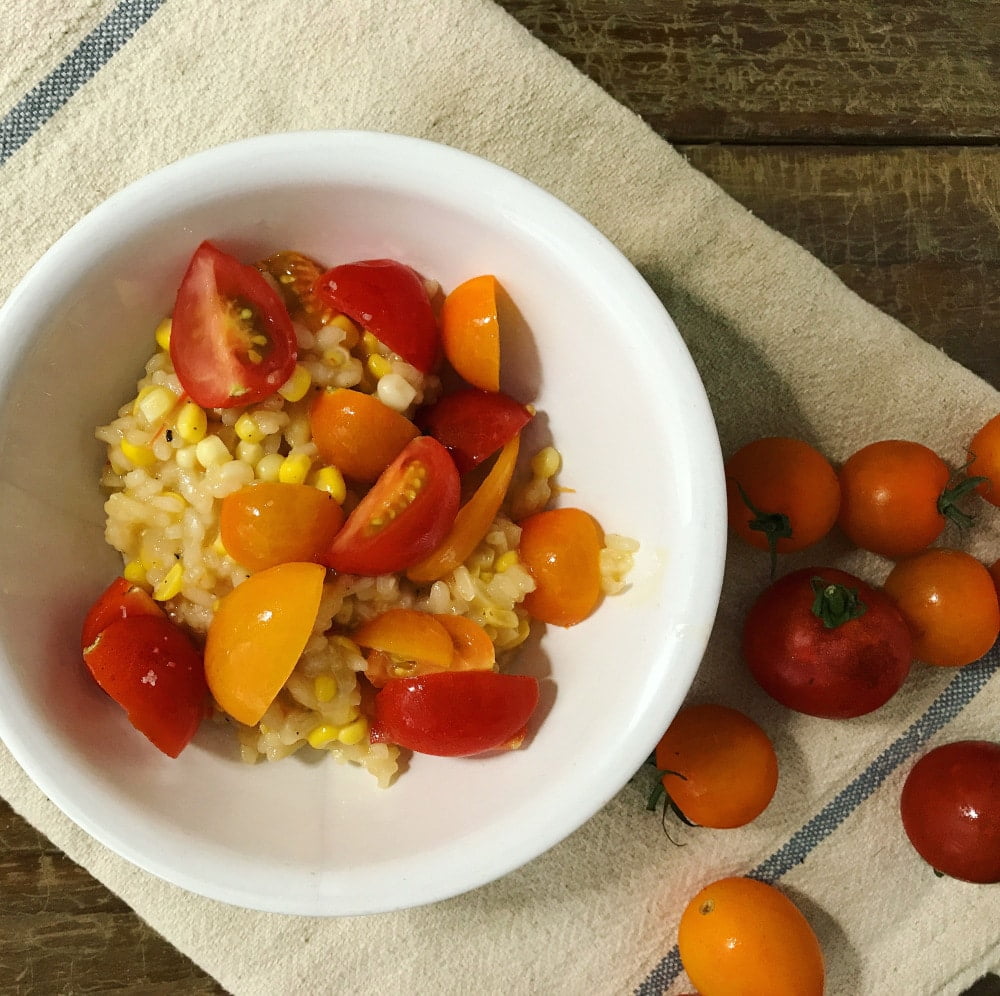
SWEET CORN RISOTTO WITH CORN COB BROTH & CHERRY TOMATOES
Adapted barely from a genius recipe from Susige at Food52
Oh my, oh my this dish! This is hands down one of the most tasty things I’ve ever consumed (and I live a pretty decadent and delicious life). I love really any combination of corn, peppers, onion and garlic but something about this risotto just sings on another level. I think the corn cob broth is the real game changer. Don’t skip this step if you can help it. It adds a little time (but also can be left alone while you get things done around the house). Also don’t omit the quartered cherry tomatoes on top. It’s a simple thing but it adds the acidity and brightness that the rich creamy risotto needs.
Takes 90 minutes (1 hour active cooking time)
Serves 4-6
5-6 ears sweet corn
6 cups water
1 tablespoon Kosher salt, divided plus more for seasoning
5-6 garlic, divided
1/4 cup butter, divided
1 tablespoon olive oil
1/4 teaspoon freshly ground black pepper
1 cup arborio rice
1/2 cup dry white wine
1/2 cup parmesan
1/4 cup minced basil leaves
1 pint cherry tomatoes (or diced tomatoes), quartered
- Husk ears of corn. With a knife, remove kernels from corn and set aside in a small bowl (hopefully there is 1-2 cups). In a large stock pot or Dutch oven, combine water and corn cobs (sans kernels) and 2 teaspoons Kosher salt. Smash 3-4 garlic cloves with the blade of your knife and remove the skin. Toss into pot.
- Bring corn cob broth to a boil and then immediately reduce to a gentle simmer. Simmer slowly for an hour. Then keep warm on very low heat to add into the risotto.
- After the corn cob broth has been simmering for about 30 minutes, begin your risotto. Melt 1 tablespoon butter with olive oil in a large saute pan (with tall sides) over medium heat. Mince remaining 2 garlic cloves and add to pot along with black pepper and remaining teaspoon Kosher salt. Cook until garlic is very fragrant and just beginning to brown, about 10 minutes. Reduce heat to low. Cook over very low heat for 15 minutes, stirring occasionally.
- Turn heat up to medium low. Add rice and cook for 2-3 minutes until it has absorbed any fat from the pan. It should look slightly puffed.
- Add the wine to deglaze the pan. Cook, stirring occasionally until the rice has absorbed all the wine.
- By now your broth should be nicely reduced to 4 cups of liquid. Remove the corn cobs with tongs. If you feel ambitious, run the back of a knife against the corn cob to get every yummy morsel of corn off the cob and into the broth. Toss the garlic gloves into the pan with the rice.
- Add three ladles of broth to the rice and stir. Let simmer gently, stirring occasionally until broth is absorbed by rice. Then add a couple more ladles of broth. Continue this process of adding broth, stirring occasionally and letting the rice absorb the broth until you’ve used all the broth and the rice is tender but not mushy. It should take about 20 minutes. (If you use up the broth before the rice is cooked enough to your likely just add a little more warm water).
- Remove pan from heat. Add reserved kernels, remaining three tablespoons butter, Parmesan cheese and basil. Stir to combine then cover and let sit for five minutes.
- Serve warm with quartered cherry tomatoes and a sprinkle of salt.
Serves 2-4 as a side (though I am known to eat the whole bowl for dinner)
Takes 15 minutes (but gets better the longer you let it sit)
3 cucumbers, cut into 1/8-inch slices
1/2 Walla Walla onion, halved and sliced
1/4 cup Greek yogurt
1/4 cup mayonnaise
2 tablespoons sugar
2 tablespoon white vinegar
Salt and pepper to taste
Dill, optional
- In a large bowl, combine cucumbers and onions.
- In a small bowl, whisk together yogurt, mayo, sugar, vinegar, salt and pepper until smooth. Pour over cucumbers and onions and toss gently to combine. Garnish or season with dill (if you like).
- Serve immediately or chill for an hour to let the flavors really meld together.
.
Lightning strike
- On: July 15, 2020
 0
0

Charlie Davis and his son Caleb came to repair our farmyard well.
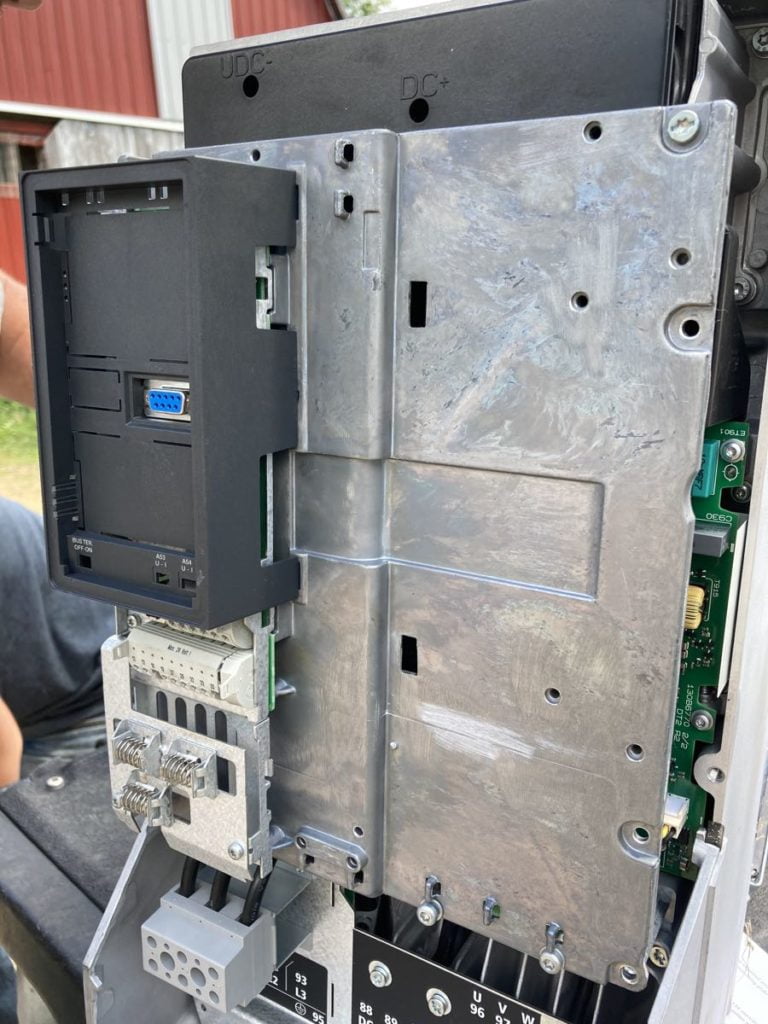
This is the inside of the well controller. It is not supposed to have the rainbow/galvanized look. That’s the result of the lightning surge.
There was a lightning strike nearby on Thursday night. No one was hurt but many electronics were damaged. Here’s the list so far:
– farmyard well controller
– irrigation well controller
– solar array controller
– a thermostatic control for one cooler
– pump for our diesel fuel tank
– controls for a mixer we use to prepare greenhouse potting mix.
That’s a lot. If we hear Steve cursing, then we know he has found more damage. We are crawling our way through repairs. Water was off in the house and farm buildings for less than a day because our well repair guy is terrific. Charlie Davis (Southcentral Well & Pump) returned our call on Thursday night, tracked down a replacement controller early Friday, and was at the farm by 11:00 am.
Steve fixed the cooler compressor and the diesel pump (more cursing) but the irrigation well and solar array remain unresolved. An electrician has declared both controllers as ‘dead.’ These are specialized and expensive parts but we have insurance.
Honestly, I kind of lost it on Thursday night. This is a complicated year and suddenly we had no water and so many essential farm systems were damaged. We filled buckets at the neighbors (thank you K & J!) and took bucket baths. Charlie’s quick reply helped. We opened a few beers and went to bed early. Beth
Basil
We are sending a substantial bunch, as the basil grew well this week. If you don’t expect to use it all within one week, you should freeze some. Chop finely by hand or in a food processor. Mix with a little olive oil, and press firmly into a shallow freezer container. Once frozen, you can break off pieces when you need them. No need to thaw; just throw a frozen chunk into your tomato sauce or salad dressing. Full disclosure, basil blackens when frozen so keep that in mind when using it.
Storage: Basil deteriorates if stored in the refrigerator. It is best stored at room temperature with the cut ends in water, for example in a jar or vase. Treat it like a flower. Give the stem a fresh trim and change the water every day or two.
Basil forecast: We think this will be a good basil year. Keep your fingers crossed. We’ve settled on a favorite disease-resistant variety, to avoid the disease that has ended our basil crops early the past few years. I think we’ll have a steady supply during tomato season.
Veggie List & Veggie Notes
Week #9, July 16/17, 2020
– Weekly shares
– EOW/ green
Carrots, 1.25 lb
Green kale, 1 bunch
Zucchini &/or summer squash, 1 or 2
Cucumbers, 3
Walla Walla onion, 1 or 2
Green bell pepper, 1
Broccoli, 1 or 2 small heads
Basil, a generous bunch
Fresh garlic, 1 bulb
– We have 1 pt cherry tomatoes for a few sites. We’ll distribute cherry tomatoes to all the sites as they ripen in the coming weeks.
– Each site gets something from this list: globe eggplant OR a few plum tomatoes OR a small bag of snap peas.
– Remember, all boxes at a site are identical. Do not touch or open other members’ boxes.
Next week’s box will probably contain cucumbers, zucchini, Caraflex cabbage, basil and more.
Carrots – These were smaller than expected at harvest. We’ll let the field grow for a few more weeks before harvesting again.
Walla Walla onions – These fat onions are sweet, crisp and very mild. Wonderful raw or lightly cooked. Try cutting into wedges, threading on a skewer and grilling. Do not try to fry these onions – it doesn’t work because of their high water content.
Storage: It’s OK to store at room temperature for up to one week. Otherwise, refrigerate.
Fresh garlic – The garlic you receive this week is freshly dug and uncured. The cloves are very crisp and pungent. You will find that the wrapper papers on each clove are still crisp but peel off readily. You should refrigerate this head of garlic. It won’t spoil at room temperature but the clove wrappers become difficult to peel as they dry. We expect to dig our garlic crop over the next week, then will cure the bulbs for a few weeks. We’ll send more garlic once the curing is finished.
Storage: Refrigerate fresh garlic.
Eggplant – For best flavor, store eggplants at room temperature for 2 – 3 days. If holding for longer than three days, store in the warmest part of your refrigerator. Eggplants do not store well for long periods of time. Many recipes instruct you to salt and drain eggplant “to remove bitter flavors.” Eggplant this fresh is not bitter so you can skip the salting step.
There are many ways to use versatile eggplants. Here are a few ideas:
– Roast in the oven or over coals to cook and smoke your eggplant, then transform into baba ganouj with lemon, tahini, and garlic.
– Cut in 1/2 to 3/4 inch slices, peel, and rub with a little salad dressing (I use Newman’s balsamic dressing), then grill slowly until soft and smoky. At this point, you can cut into cubes to make eggplant caponata with chopped tomatoes, onion, garlic, olives, capers, olive oil and red wine vinegar.
– Use the grilled cubes in casseroles or to top pizza.
– Add thin, grilled eggplant slices in grilled cheese sandwiches. Use hearty bread – this doesn’t work well with soft sandwich bread.
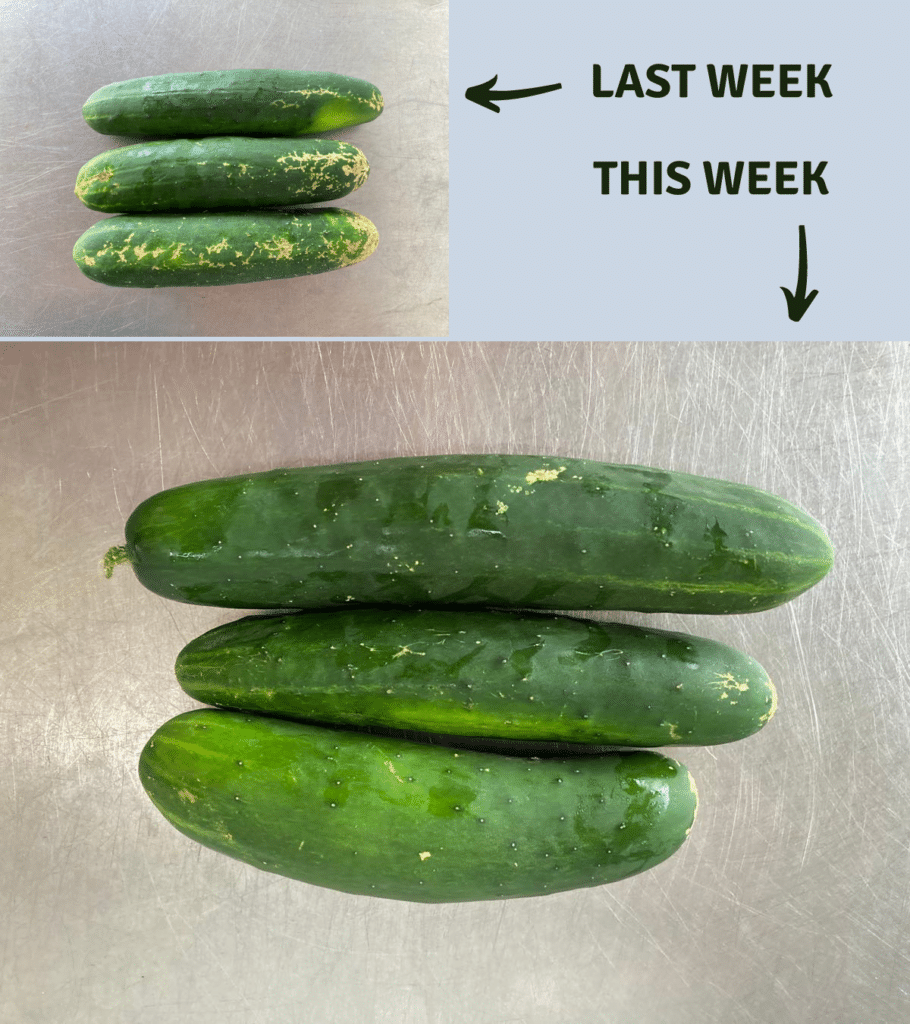
See? The cucumbers already look better, with less beetle damage.
RECIPES
Visit our 2020 Recipe Log or our 2019 Recipe Log or join our Facebook discussion group.
LOCAL THYME/ Cooking 101
Baked Eggplant Fries
Pasta Sorta Gricia
Basil Oil Grilled Crostini with Goat Cheese
LOCAL THYME/ Cooking 202
Creamy Polenta with Eggplant and Zucchini
Chicken Noodle Soup with Cannellini Beans and Kale Pistou
Basil Cucumber Buttermilk Dressing
LOCAL THYME/ Quick & Easy Meal
Olive Hummus, Basil, Cucumber, Zucchini, Carrot Wraps
RECIPES FROM LAUREN
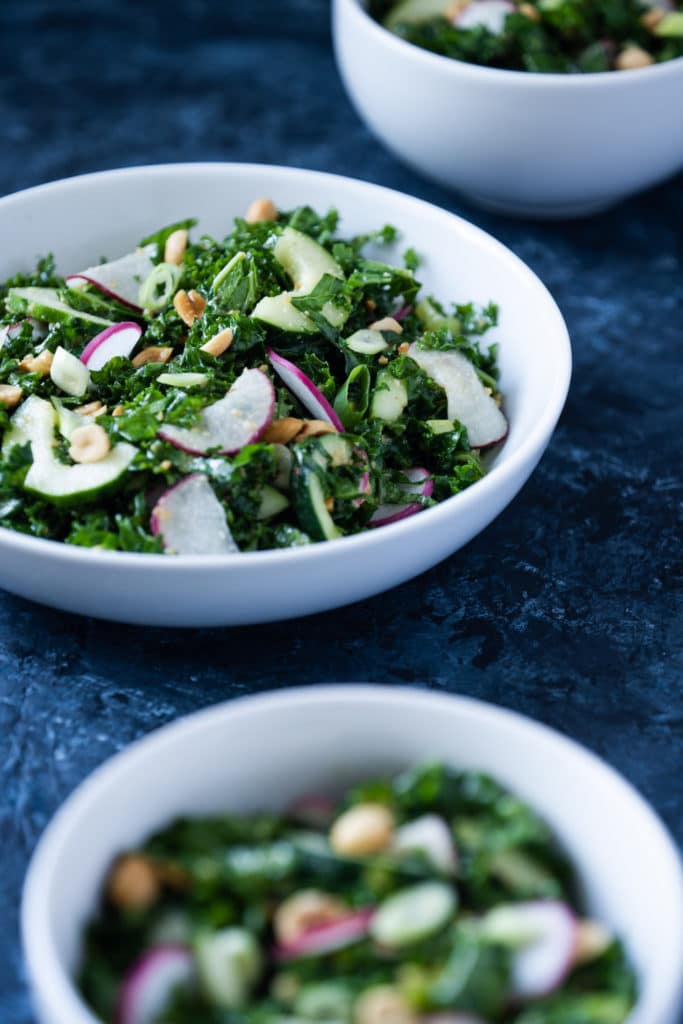
KALE PEANUT SALAD
Adapted from Martha Stewart
Depending on the season, I change up the veggies I use for this salad. The kale and the dressing are the powerhouse part of this meal and the rest is easily substituted so don’t worry if you don’t have any scallions or radishes on hand at the moment. I always use an onion of some kind– sometimes scallions as listed here, but at other times it’s thinly sliced yellow onion, leek or shallot. I usually use a root vegetable as well– sometimes radish, sometimes carrot, occasionally beets. Then I’ll add another veggie or two, again whatever I have on hand, cucumbers and bell peppers of any color are great. Really anything you like raw on a salad will work just fine.
1-1/4 cup roasted salted peanuts, divided
6 tablespoons vegetable oil
5 tablespoons apple cider vinegar
3 tablespoons brown sugar
1 teaspoon Kosher salt
1/2 teaspoon red pepper flakes
1 pound kale (or collards), ribs removed and very thinly sliced
1-2 cucumbers, seeded and sliced
1 Walla Walla onion, thinly sliced
- In a food processor, combine 3/4 cup peanuts, oil, vinegar, brown sugar, salt and red pepper flakes. Process until smooth. Taste and adjust seasoning as desired.
- In a large bowl, combine kale with the dressing, using half at first, tasting and adding more as you like. I often use the full amount for a pound of kale but you may not want to.
- Top with cucumber, onion and remaining 1/2 cup nuts. Serve right away or store for 2-3 days in your fridge. The kale can stand up to being dressed in advance.
.
????
.
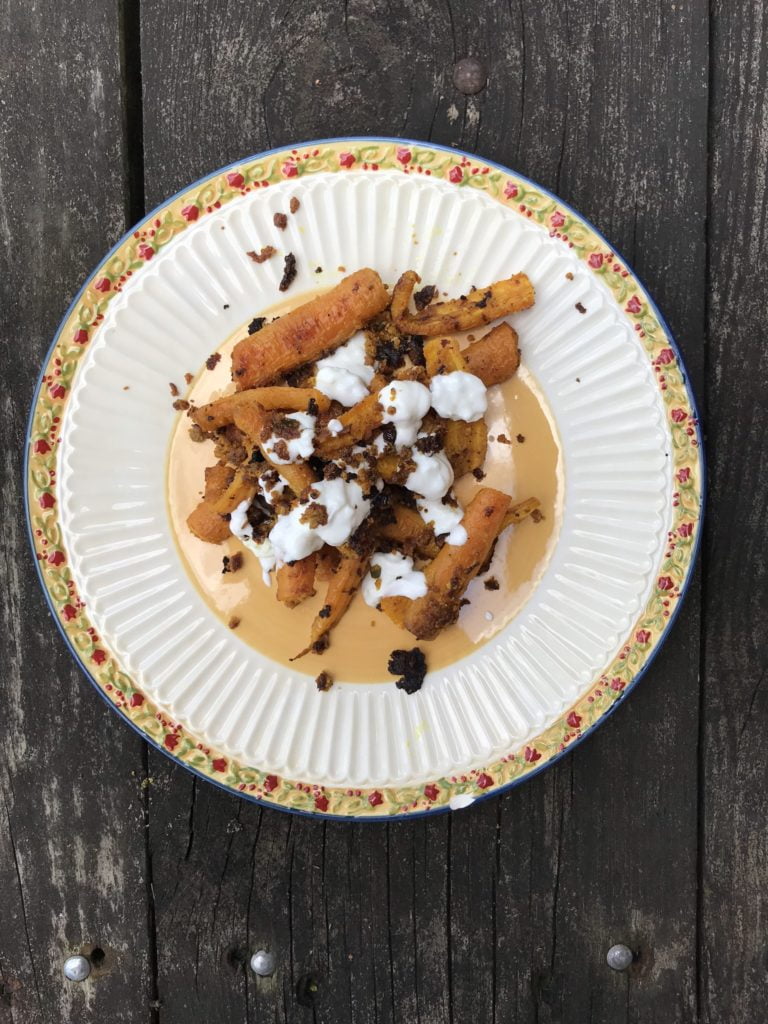
INDIAN-SPICED CARROTS WITH YOGURT
Adapted from Bon Appetit
Serves 2-4 (as a side)
Takes: 45 minutes
½ cup Greek yogurt, divided
1 tablespoon curry powder (preferably hot curry powder)
1-1/2 teaspoons onion powder
1-1/2 teaspoons garlic powder
2 garlic cloves, minced, divided
3 tablespoons olive oil
1 pound carrots, unpeeled, tops trimmed, cut in half if large
2 tablespoons lemon juice
Kosher salt and freshly ground black pepper, to taste
- Preheat oven to 450 degrees. Mix together ¼ cup yogurt, curry powder, onion powder, garlic powder, 1 minced garlic clove, and olive oil in a large bowl until smooth. Season well with salt and pepper. Add carrots and toss to coat. Roast on a baking sheet in a single layer, turning occasionally, for 30 minutes. You’ll want them to be lightly charred in spots and very tender.
- Meanwhile, whisk together lemon juice, remaining garlic clove and remaining ¼ cup yogurt in a small bowl. Season well with salt and pepper.
- Place cooked carrots on a platter (along with any crunchy bits left on the baking sheet). Drizzle with yogurt mixture. Serve warm.
- Or skip the platter and put all the carrots and yogurt on one plate and dive in (without sharing!).
.
????
.

BROCCOLI PESTO QUICHE
Makes 6 servings
Takes 1 hour
1 pie pan lined with pie dough (from scratch or store-bought)
1 cup finely diced broccoli
1 Walla Walla onion, thinly sliced
1 green pepper, diced
1 cup shredded cheddar or Gruyere cheese
1 tablespoon flour
3 eggs, lightly beaten
1 cup half-and-half, whipping cream or milk
1/4 cup prepared pesto (recipe below) or 1/2 cup finely chopped basil if you’re feeling less ambitious
1/4 teaspoon salt
1/8 teaspoon pepper
- Preheat oven to 425 degrees.
- Prick bottom and sides of crust and line with foil. Bake in preheated oven 8 minutes, remove foil, and bake another 8 minutes. Reduce oven to 325 degrees.
- Toss broccoli, onion, peppers, cheese and flour in a bowl. Spread mixture over bottom of crust. Whisk remaining ingredients in the bowl. Pour filling into crust. Bake until knife inserted near center comes out clean, about 35 to 40 minutes.
.
Basil Pesto:
3 tablespoons pine nuts (or walnuts or almonds)
1/4 cup shredded Parmesan
1 garlic clove
2 cups basil leaves
1/4 cup olive oil
Salt
Pepper
- Combine pine nuts, Parmesan and garlic in a food processor, blender or mortar and pestle. Process until finely ground. Add basil and process 20-30 seconds longer until combined. Remove to a small bowl and fold in olive oil. Season to taste with salt and pepper. Makes 1/2 cup.
.
Week #8, Other farmer friends made the same decision.
- On: July 08, 2020
 2
2
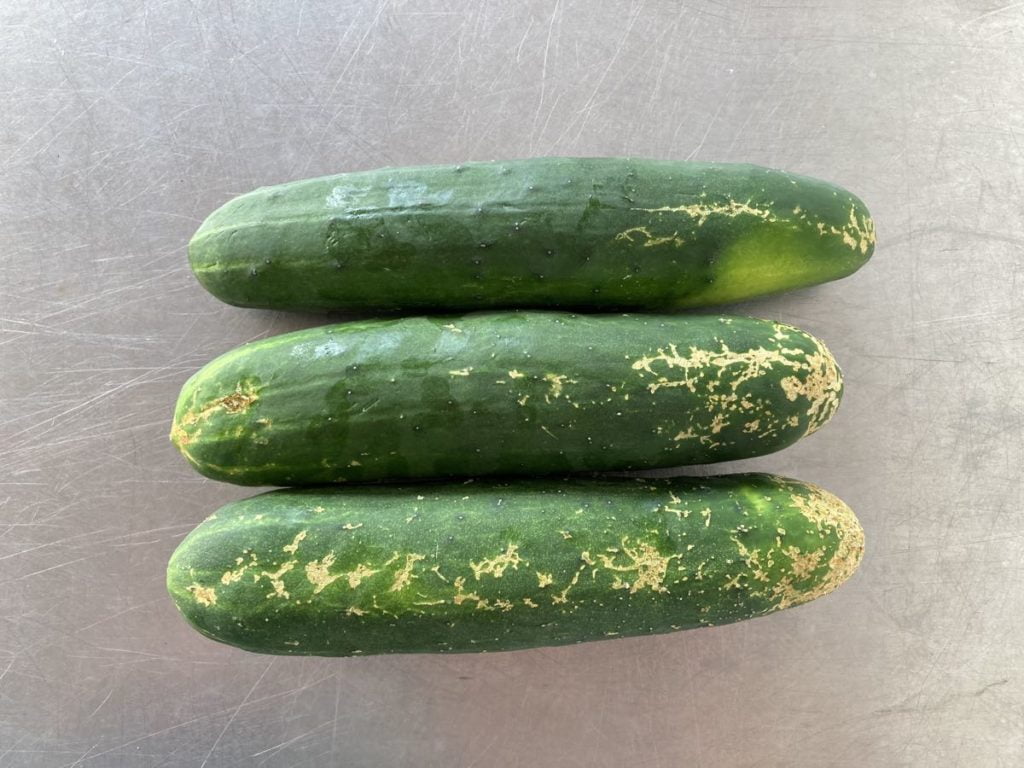
Almost every cucumber has some level of insect feeding damage. Consider peeling your cukes, at least the sides with scarring.
A grower on our farmer listserv wrote that he missed the window to protect his zucchini seedlings with row cover, and that the cucumber beetles became unrelenting. That happened for us too, as well as other local farms. Steve replied with this explanation of why we didn’t get our usual row cover protection in place. Row cover is lightweight fabric that we use to cover fields in spring to capture warmth and exclude insects.
“We also are seeing very large numbers of cuke beetles this late spring. For many years we have transplanted zucchini, summer squash, cucumbers and melons into green plastic mulch and applied row covers within one to two days. This year we missed that window for covering, and were inundated with beetles. Why didn’t we cover right away? We didn’t have our drip irrigation set up; the main line got torn up last fall and we had yet to rebuild it. The hot sunny weather after transplanting made covering very risky – we’ve lost too many cucurbit plants by covering during hot spells without concurrent drip irrigation. Also, we finished transplanting on a Friday evening– 2 hours after our usual quitting time. By Monday morning, when our crew returned, it was too late.”
Sometimes a tweak of the weather has unplanned consequences. We worked late that Friday night to get the zucchini planted before a rain storm and this was the outcome. It’s interesting to learn that other farmers’ decision-making converged in this way.
We’ve begun harvesting both zucchini and summer squash so clearly the crops survived. Green zucchini harvests are low for now; a few varieties were particularly hard-hit by the beetles. The cucumbers have a lot of insect scarring; they are the beetles’ favorite host. Let’s wait and see if the scarring abates once there are more cucumbers in the field to spread the beetle damage.
Our crops (and weeds!) grow 50% faster in weather this hot.
Can we work 50% faster?
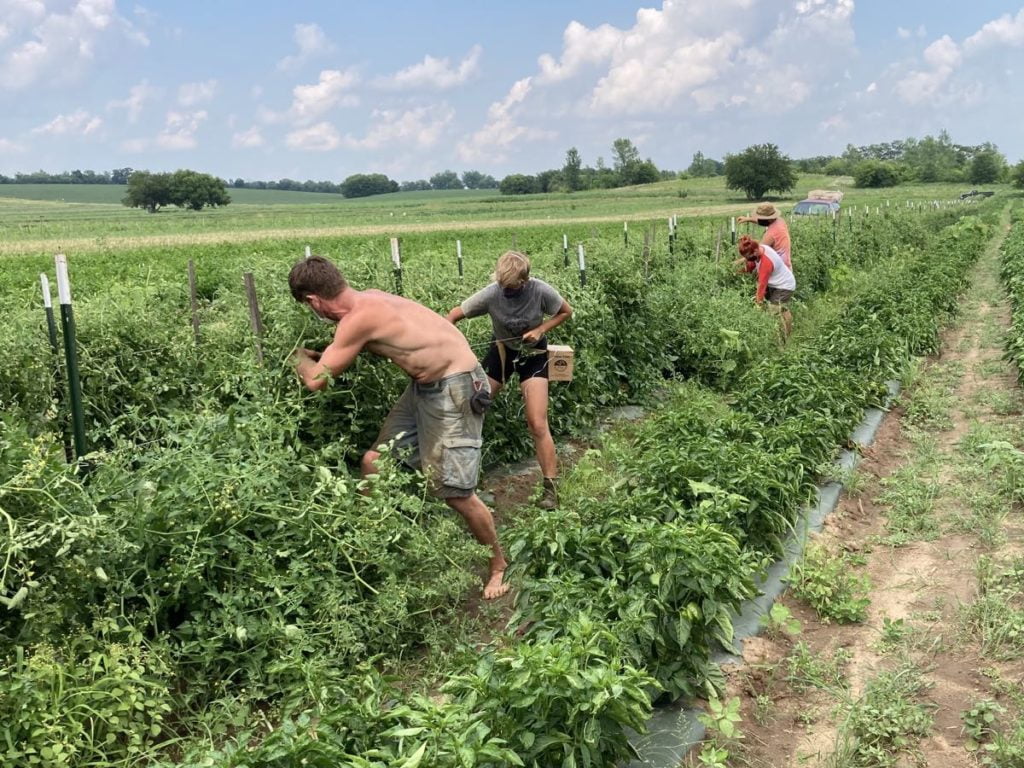
Obviously not. Our work is very difficult in the ridiculous heat. We need lots of water and Gatorade and more breaks in the shade than usual. In the photo, Billy, Demi, Courtney and David trellis tomato plants. The tomato growth rate has been astonishing and the plants got tossed over during recent storms. One person gathers the plants while the other person weaves string around them in a supporting figure-eight pattern, tied to the stakes. With this dastardly job, we can’t even take off our masks because we’re working so close together. Otherwise, masks are off whenever we can work far apart outside.

Our heavy barn fans save the day. We bought several to dry garlic in our barn loft. Now we use them for ventilation and to cool our work spaces. They are so, so great.

We suspended tarps over a corner of the pack shed. We appreciate the light from our tall peaked roof but the sun is too much for us right now.
Veggie List & Veggie Notes
Week #8, July 9/10, 2020
– Weekly shares
– EOW/ purple
– Sampler/ moon
Sugar snap peas, 2 1/4 lb
Cucumbers, 4
Zucchini or summer squash, 2 to 2.5 lb
Red bibb lettuce
Green bell pepper, 2
Broccoli, a few heads
Basil, 1 – 2 large sprigs
Garlic scapes, 1 small handful
Some sites get 1 sunflower, for beauty.
Next week’s box will probably contain cucumbers, zucchini &/or summer squash, Walla Walla onion, basil and more.
Sugar snap peas – This has been an amazing pea season, despite the heat. Enjoy this huge bag.
Cucumbers – I bet you all know what to do with cucumbers.
Storage: Cucumbers need refrigeration but do best at about 48 F. Store in a warmer part of your fridge – that’s the best compromise.
Green bell pepper – The first of the season!
Basil – Yum, the first tender basil, perfect to combine with garlic scapes, zucchini, snap peas, etc.
Storage: Basil will blacken if stored in the refrigerator. It is best stored at room temperature with the cut ends in water, for example in a jar or vase. Treat it like a flower. Give the stem a fresh trim and change the water every day or two.
Garlic scapes (curly green things) – Use scapes as a substitute for garlic cloves. They can be minced, mixed with olive oil, and added to stir fries or simple pasta dishes. The scapes can be sautéed, but will not brown like garlic cloves. Expect them to retain their crunch even when cooked, and to be milder than garlic cloves, closer in pungency to the green garlic we’ve sent.
Sunflower (for some sites) – We continue experimenting with sunflowers. They are one of the few flowers that we can send in the CSA boxes. This cheerful variety ‘Vincent’s Choice’ does not produce pollen, making it a good choice to pack with vegetables. The sunflowers are for beauty and joy, not to eat!
Storage: Trim the stem and place in water. If you re-trim the stem and change the water a few times, the flower should last about one week.
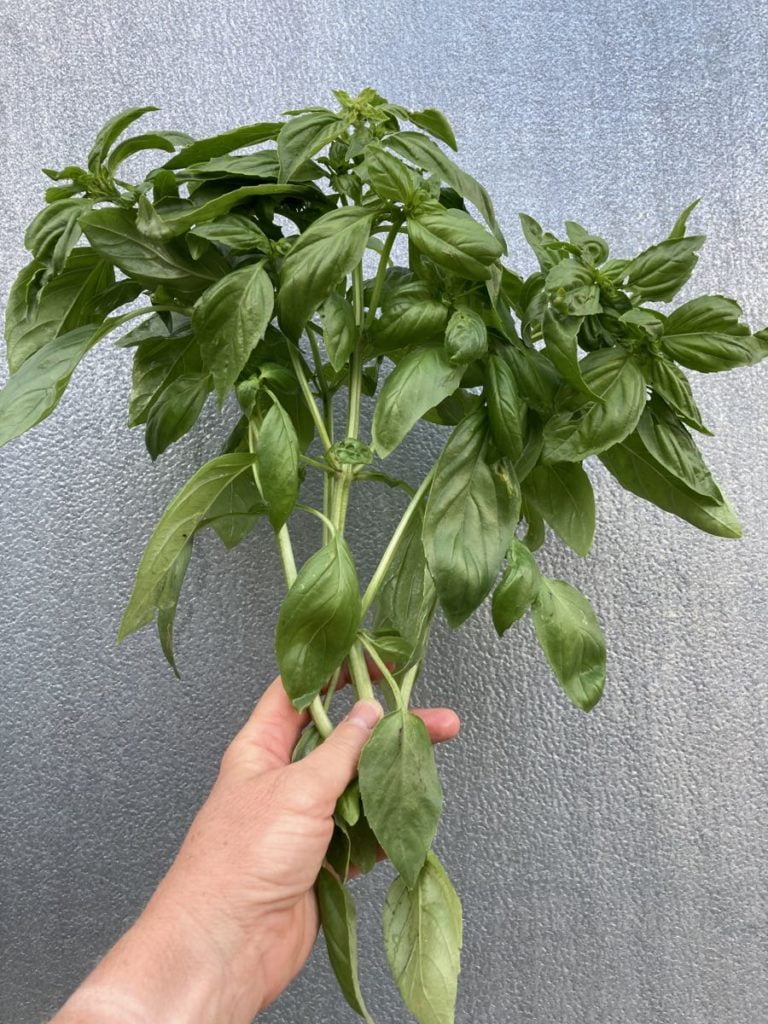
Everyone gets one or two branched sprigs of basil.
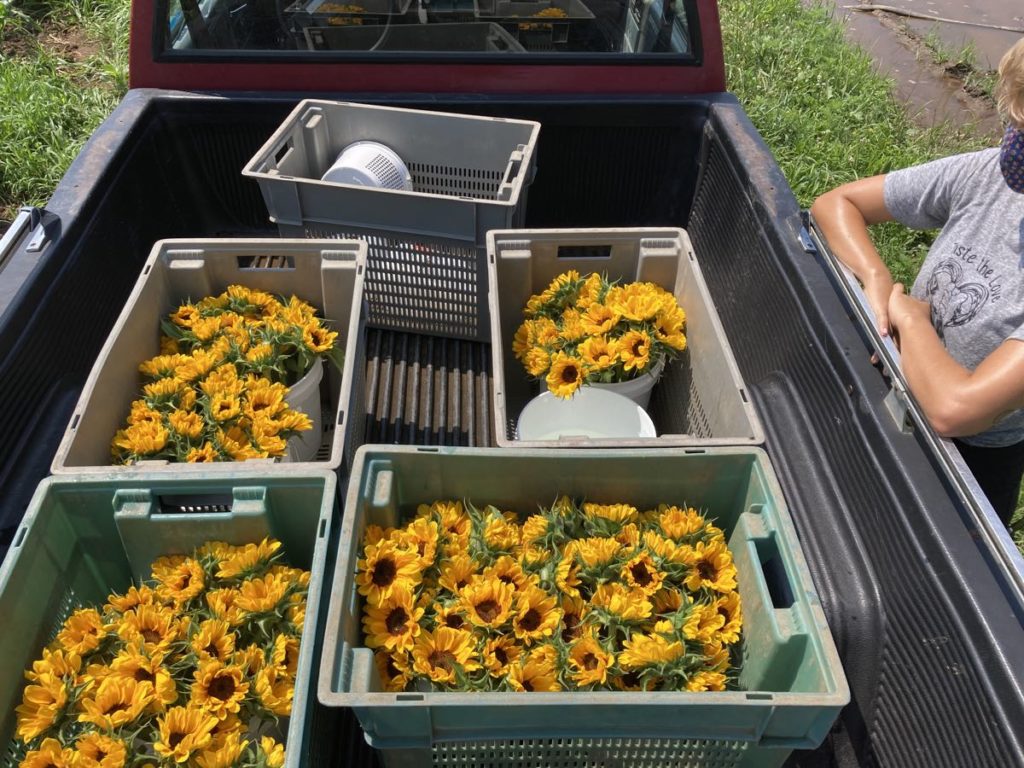
A load of sunflowers, with Demi.
RECIPES
Visit our 2020 Recipe Log or our 2019 Recipe Log or join our Facebook discussion group.
LOCAL THYME/ Cooking 101
Broccoli Pesto
Broccoli, Cucumber and Pepper Salad with Sesame
LOCAL THYME/ Cooking 202
Broccoli Sausage Strata
Thai Pickled Cucumber
Quinoa Salad with Snap Peas, Garlic Scapes, and Zucchini
LOCAL THYME/ Quick & Easy Meal
Broccoli Pesto Flatbreads with Grilled Zucchini
RECIPES FROM LAUREN
Takes 15 minutes
Serves 2-4
1-2 pounds snap peas (as many as you are willing to spare), cut in half lengthwise
1 head lettuce, leaves torn
3 tablespoons olive oil
2 tablespoons lemon juice
Kosher salt
Black pepper
1 (8 ounce) ball or 2 (4 ounce) balls fresh burrata
1. In a large bowl, toss snap peas (cut in half lengthwise) and any peas that fall onto your cutting board with lettuce.
2. Drizzle with olive oil, lemon juice, a good pinch of Kosher salt and several grinds of freshly ground black pepper. Toss to combine. Taste and adjust seasonings as desired.
3. Serve with burrata and a few more grinds of pepper.
.
????
.
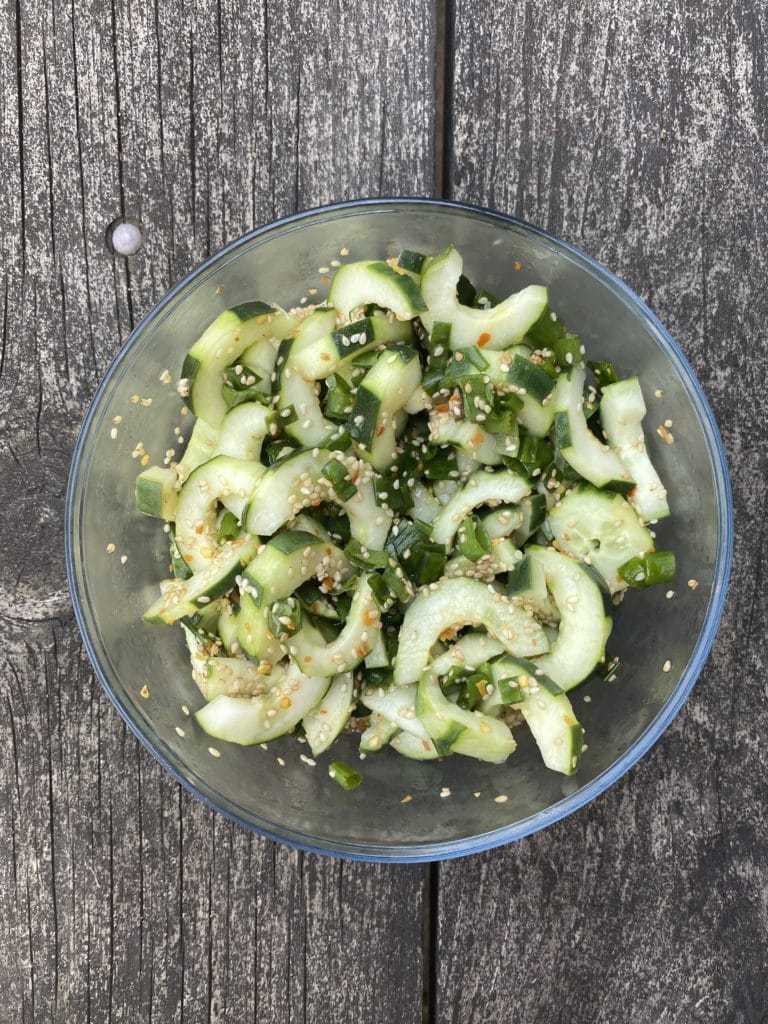
CRUNCHY CUCUMBER SALAD
Takes 10 minutes
Serves 2-4
3 cucumbers, halved lengthwise and seeded
1 tablespoon rice wine vinegar
1 tablespoon olive oil
2 tablespoons sesame seeds
1 teaspoon sugar
1/2 teaspoon red pepper flakes
1/4 teaspoon Kosher salt
1. Combine all ingredients in a medium bowl. Toss to combine. Eat at room temperature or chill before serving. It will get a bit soggier than longer you wait to eat it, but still taste delicious.
.
????
.
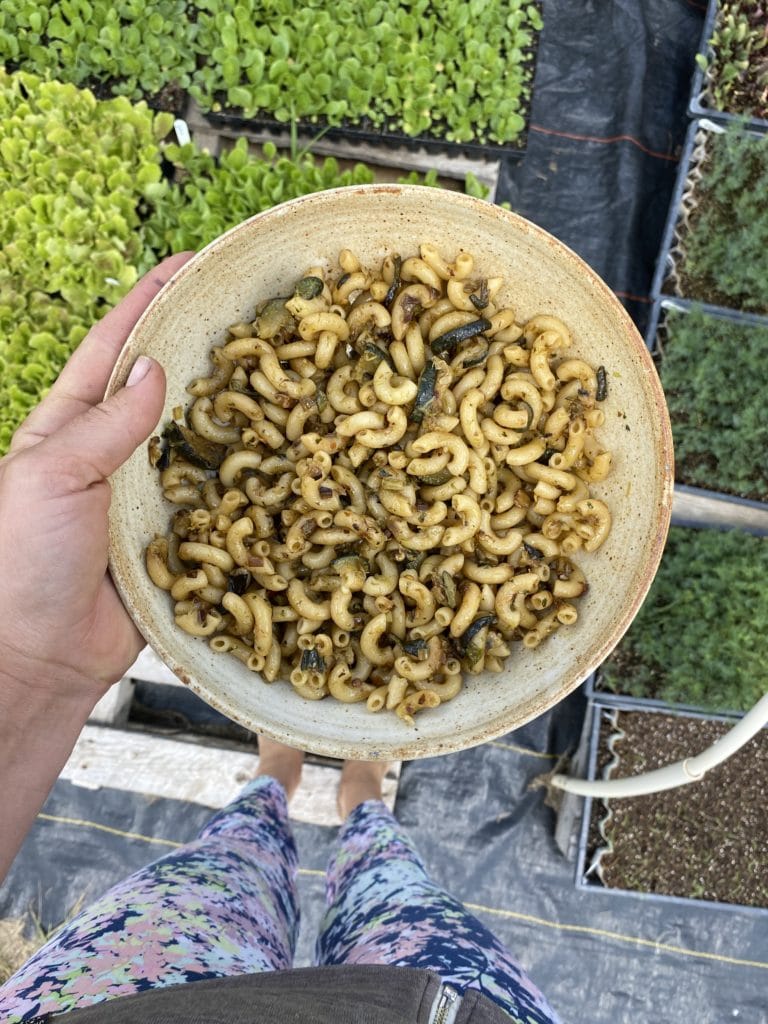
JAMMY ZUCCHINI PASTA
Takes 40 minutes
Serves 4-6
1/4 cup olive oil
1 bunch garlic scapes, thinly sliced
2 green peppers, diced
2 pounds zucchini, quartered lengthwise and sliced
1/2 teaspoon red pepper flakes
12 ounces pasta of your choice (ziti or elbows work great)
2 ounces Parmesan, finely grated
1/4 cup basil leaves
- Heat oil in a large skillet over medium heat. Cook garlic scapes until lightly browned, about 5 minutes. Add peppers and zucchini. Increase heat to medium high and sprinkle mixture with salt (about 1/2 teaspoon). Let it cook until the zucchini begins to break down then turn heat to low. Continue cooking and stirring until squash is jammy and soft, about 15 minutes. It will stick a little bit. Don’t worry about that. Add pepper flakes.
- Meanwhile, bring a large pot of salted water to a boil on the stovetop. Cook pasta according to package direction. When done, drain, reserving 2 cups of pasta water.
- Transfer pasta to zucchini mixture and add half the reserved pasta water. Stir with a wooden spoon to combine and scrape any of the jammy zucchini from the bottom of the pan. Add cheese and stir until sauce coats pasta. Add more pasta water if the mixture is too thick or the cheese is clumping/not mixing well. Remove from heat and add in the basil.
- Enjoy warm!
.
Week #7; Our thoughts on the u-picks
- On: July 01, 2020
 0
0

From left, your strawberry guide Ari in 2014, and this year at age 17.
We hosted a second strawberry u-pick last weekend, by reservation only. This one was much calmer than the u-pick held on Fathers’ Day. We scheduled up to 10 groups per 20-minute arrival window and that worked smoothly.
Scheduled reservations seems an obvious u-pick strategy whether there’s a pandemic or not. Let me explain why we have avoided them until now. It is very difficult to predict how many strawberries are in a field. That’s why most u-pick farms simply offer berries “until sold out.” If we offer a reservation, it is an implicit promise there will be berries when you arrive, even for later reservations. Imagine if we ran out of berries for the later groups and someone had travelled all the way from Milwaukee? What a mess. By this past weekend, we had a better idea of how many berries were in the field. However, we also ‘under-sold’ our reservations, knowing that some berries would go unpicked. That’s exactly what happened. While a waste, it was necessary to make the u-pick run smoothly.
I am explaining our thoughts and experiences because it’s clear that we will need to consider reservations for other u-picks this year. We will do our best to make the events ‘fair’ for everyone (eg by offering Milwaukee-area members the first chance at early arrival times) but no system will be perfect. At the same time, we cannot overtax our own limited time and energy. The farm consumes all of our energy right now. All!
We consider this past weekend a success. Feedback from attending members was excellent. A few people had attended both u-picks, so they got to experience how calm the second weekend was. Other members confided that they had driven to the farm on June 21, were uncomfortable with the number of people, and simply drove away. This weekend was a better system.
Finally, I would like to acknowledge our son Ari, your strawberry guide both weekends. He was a whirling dervish the first weekend! Let’s give him a round of applause!
Beth
Experiences of the week
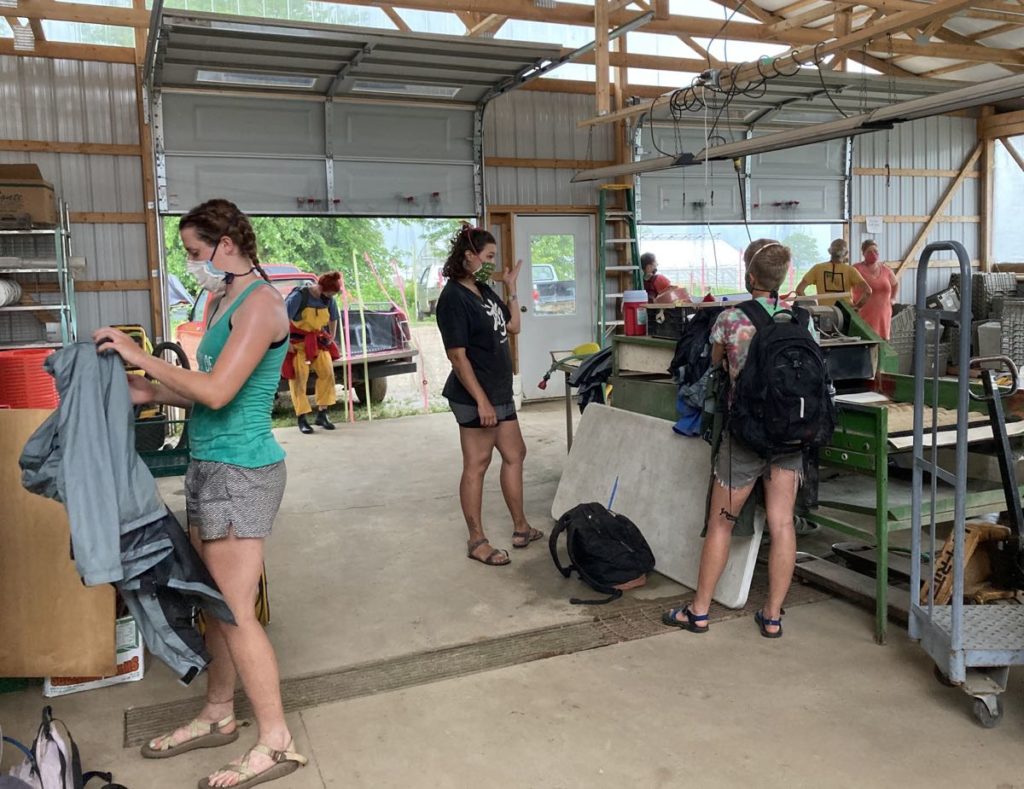
The weather forecast on Monday predicted 1/10 inch rain, with a brief, midday thunderstorm. We gathered after lunch and decided to wait while the lightning passed. Then another cell popped up, then another. The deluge went on for over an hour, totaling 2.5 inches. Steve went out and turned off the irrigation. In the meantime, we did a few chores but mostly socialized in our spacious pack shed. Crew members told me afterwards how much they enjoyed this hour together. We work in teams, which are social, but this rainy day break was oddly enjoyable.
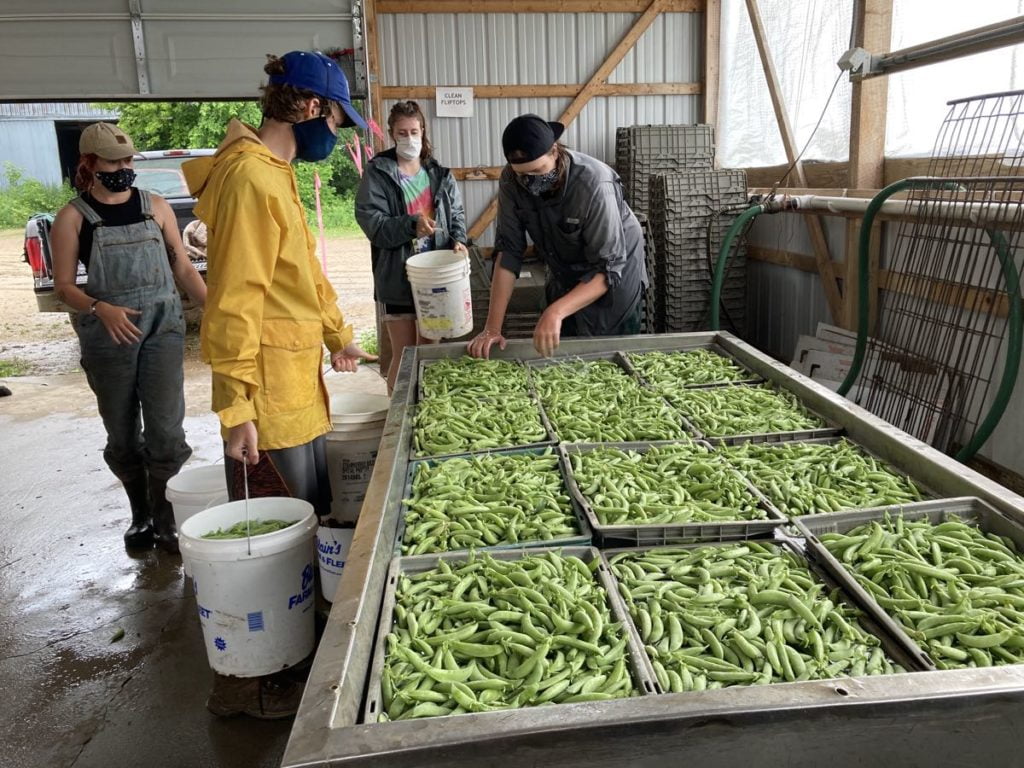
From left, Courtney, Ari, Zoe and Chance bring in the snap pea harvest. It was a very productive week for peas!
Veggie List & Veggie Notes
Week #7, July 2/3, 2020
– Weekly shares
– EOW/ green
Strawberries, 1 scant pint
‘Caraflex’ cabbage, 2 medium
Sugar snap peas, 1.2 lb
Zucchini or summer squash, 1 – 1.75 lb
Romaine lettuce
Broccoli, 1 small head
Scallions, 1 bunch
Parsley, 1 bunch
Garlic scapes, a handful
– Some sites get Swiss chard.
– Some sites get Red Russian kale.
Next week’s box will probably contain cucumber (we hope!), zucchini, sugar snap peas, lettuce, basil, garlic scapes and more.
Strawberries – Folks, these berries survived 2.5 inches of rain on Monday. They are ripe and perishable and need to be eaten immediately. We’ll have either a pint or a half pint for everyone, and will find out when finish our berry harvests in the morning.
‘Caraflex’ cabbage – This is a nice salad-type that we grow in summer. Don’t you love the pointy shape? It has thinner, more tender leaves than the usual green cabbage. Great in salads and slaws but can also be cooked. Here’s the description from the seed catalogue: “Inner leaves are tender, crunchy, and have an excellent, sweet and mild cabbage flavor. Perfect for summer salads, slaws, or cooked dishes.” We’re sending it this week so you can make slaw for your holiday picnics.
Scallions – This is the last batch of scallions until fall. We hope you enjoyed them.
FOR SOME SITES, Swiss chard (pretty bundle of green leaves) – Our crew did a nice job mixing colors for pretty bunches. Swiss chard is a close relative of spinach, but requires a bit more cooking. Use as a substitute in any recipe that calls for spinach, just cook the chard a little longer. Both stems and leaves are delicious. The stems requite longer cooking, so cut them free from the leaves when preparing. That allows you to cook the stems longer.
Garlic scapes (curly green things) – Garlic scapes grow at the top of garlic plants. They look like flower buds but are actually clusters of tiny bulblets. We snap off the young scapes to direct the plants’ energy into forming garlic bulbs underground. Use scapes as a substitute for garlic cloves. They can be minced, mixed with olive oil, and added to stir fries or simple pasta dishes. The scapes can be sautéed, but will not brown like garlic cloves. Expect them to retain their crunch even when cooked, and to be milder than garlic cloves, closer in pungency to the green garlic we’ve sent.
RECIPES
Visit our 2020 Recipe Log or our 2019 Recipe Log or join our Facebook discussion group.
LOCAL THYME/ Cooking 101
Smoked Trout, Snap Pea and Cabbage Pasta Salad
Snap Pea and Strawberry Salad
Greek Swiss Chard or Kale Fritters
LOCAL THYME/ Cooking 202
Warm Japanese Cabbage Salad
Precious Snap Pea Sauté
Provençal Omelet
RECIPES FROM LAUREN
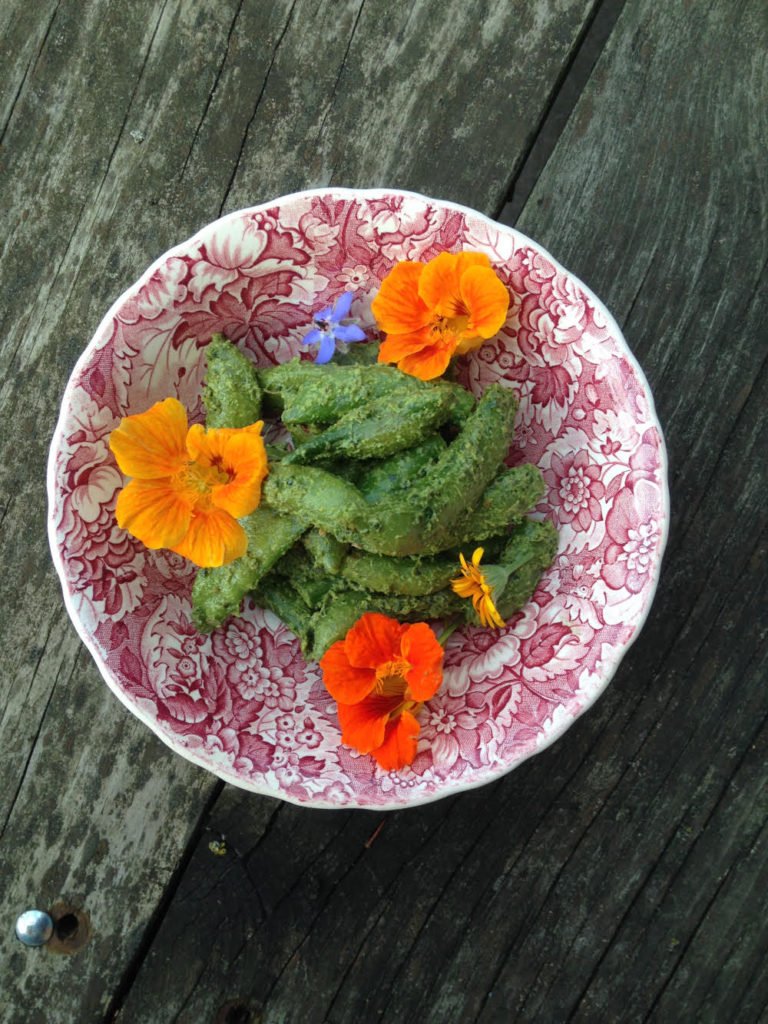
SNAP PEA SALAD WITH CHARD & PISTACHIO PESTO
Takes 15 minutes
Serves 2-4 as a side + lots of leftover pesto for your fridge
4 cups snap peas or snow peas, ends trimmed
2-4 tablespoons Chard & Pistachio Pesto (see below)
1/2 teaspoon Kosher salt
1/2 teaspoon red pepper flakes
1/4 teaspoon freshly ground black pepper
Nasturtium, borage or other pretty edible flowers, optional
- Bring a large pot of water to a boil over high heat. Blanche peas for two minutes, drain and rinse with cold water.
- Add peas to a small bowl with remaining ingredients and toss to coat evenly. Enjoy warm or cold (I like it best some hours later once it’s been chilled.
.
Chard & Pistachio Pesto
1 bunch rainbow chard (5-6 leaves), well dried
1/2 cup shelled and toasted pistachios
2 garlic cloves (or 2-3 garlic scapes)
1 teaspoon Kosher salt
1/2 cup olive oil
1-3 teaspoons lemon juice
- Prepare rainbow chard. Remove stems and roughly chop. Set aside. Tear leaves into small pieces.
- In a food processor, chop pistachios until finely ground. Add garlic, salt and chard stems. Process until consistent in size and then add leaves. Continue to puree until leaves are all finely chopped, you may have to scrape down the sides occassionally.
- Turn the food processor on and run it while you drizzle in the olive oil. Process until smooth. Add lemon juice to taste.
.
????
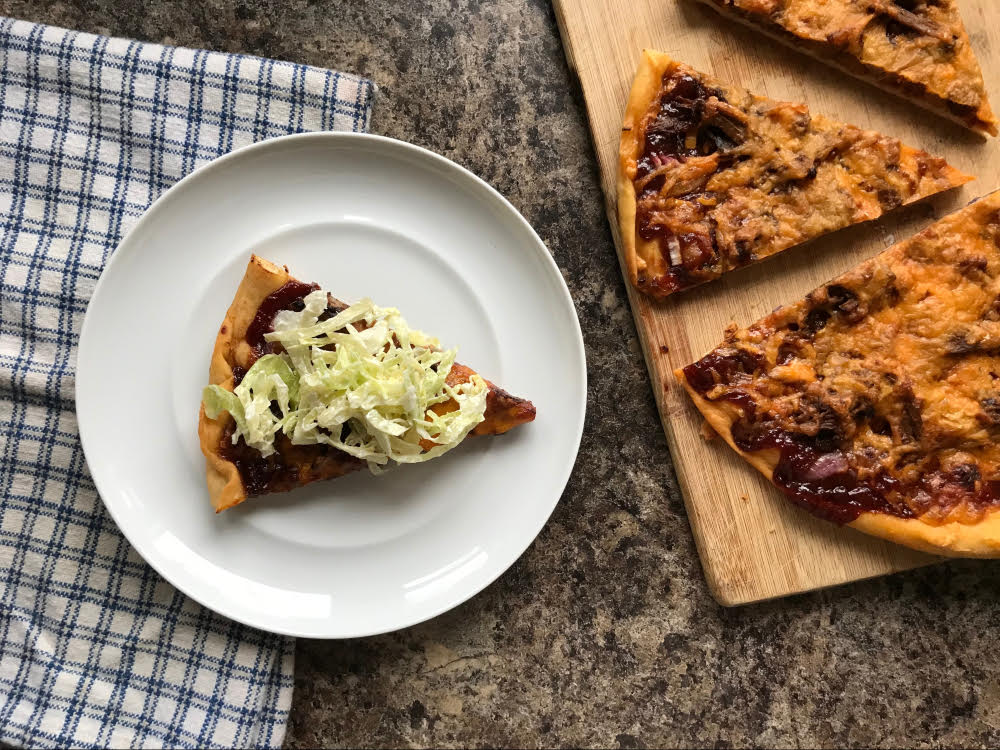
BBQ BRISKET PIZZA WITH COLESLAW
Takes 8 hours, if using slow cooker to make brisket, though only about 45 minutes of active time are involved
Makes two 14-inch pizzas
Serves 6-8
1 batch favorite pizza dough
2/3 cup favorite BBQ sauce
1/2 bunch scallions, thinly sliced
2 cups smoked cheddar cheese
Brisket:
3 tablespoons smoked paprika
2 tablespoons ground black pepper
2 tablespoons Kosher salt
1 tablespoon brown sugar
1 tablespoon chili powder
1 teaspoon ground cumin
2-3 pounds beef brisket
3/4 cup BBQ sauce
1/4 cup water
1 tablespoon Worcestershire sauce
1 yellow onion, thinly sliced
Coleslaw:
1/3 cup Greek yogurt
Juice of 1/2 lime
1-1/2 tablespoons olive oil
1/2 teaspoon Kosher salt
1/8 teaspoon freshly ground black pepper
1/2 medium head cabbage, shredded
- As advised above, the real work for this delicious pizza should start a couple days before you want to make it. You can store the dough until your fridge until you’re ready to use it. If you prefer to make it in the morning for the evening, just leave it in a cool place in your kitchen to slowly rise all day. You can absolutely also buy a store-bought dough if you like.
- The next step is making that tasty brisket. I like to start this in the morning before I head to work. Combine paprika, pepper, salt, brown sugar, chili powder, and cumin in a small bowl. Pat all over brisket.
- Place brisket in slow cooker (You could also do this night of in a Dutch oven in the oven or likely very quickly in an Instant pot) and surround with BBQ sauce, water, Worcestershire sauce and onions. Bake on low setting for 6-8 hours or high setting for 3-4 hours.
- When you’re ready to bake your pizza, preheat oven to 450 degrees.
- Divide pizza dough into two 12-inch round pizzas (you can also fit the dough to two baking sheets). Cover each round with 1/3 cup BBQ sauce.
- Shred approximately 2 cups of brisket and divide between the two pizzas. Sprinkle with scallions and cheddar cheese. Bake for 20 minutes.
- While the pizza bakes, throw a quick coleslaw together. In a small bowl, whisk together the yogurt, lime, olive oil, salt and pepper. Pour over the cabbage and toss gently. Use a spatula to scrape the sides of the bowl until dressing evenly coats cabbage.
- Serve pizza warm with coleslaw on top.
.
????
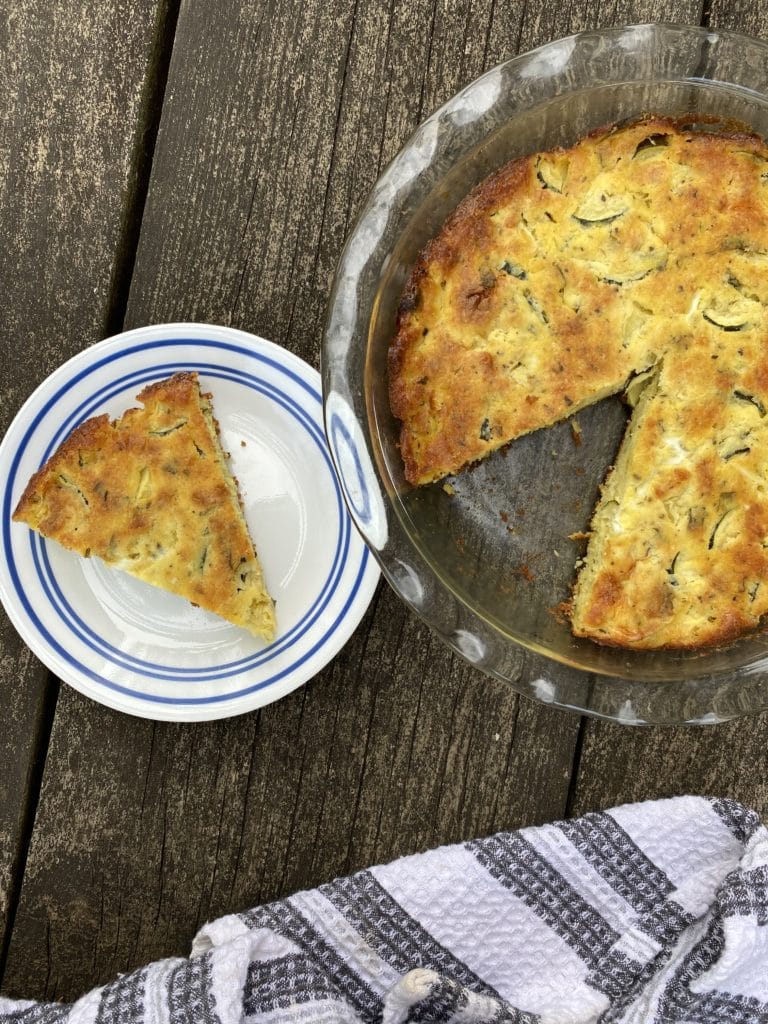
Zucchini Pie
This recipe comes straight from my momma—an excellent Midwest home cook. It calls for Bisquick because my mom loves things like that but if you don’t have any on hand, just use this great homemade substitute.
Takes 45 minutes
Serves 3-4
3 eggs
1 cup grated parmesan
½ cup canola oil
¼ cup diced fresh parsley
6 minced garlic scapes
¼ teaspoon salt
Pinch pepper
3 cups thinly sliced small zucchini
1 cup Bisquick
½ bunch scallions, thinly sliced
- Preaheat oven to 350 degrees.
- In a large bowl (or the mixing bowl of your stand mixer), combine eggs, parmesan, oil, parsley, garlic scapes, salt and pepper. Stir until well combined.
- Add zucchini, Bisquick, and scallions. Stir until all ingredients are combined but the mixture is not overmixed.
- Pour into a greased 9-inch pie pan (or 9×9 baking dish). Bake for 25-35 minutes until golden brown on top. If it’s not golden brown on top, the middle will likely not be cooked through. Wait for the pie to take on a golden hue before removing it to the oven. Serve warm on its own or alongside any roast meat.
.

